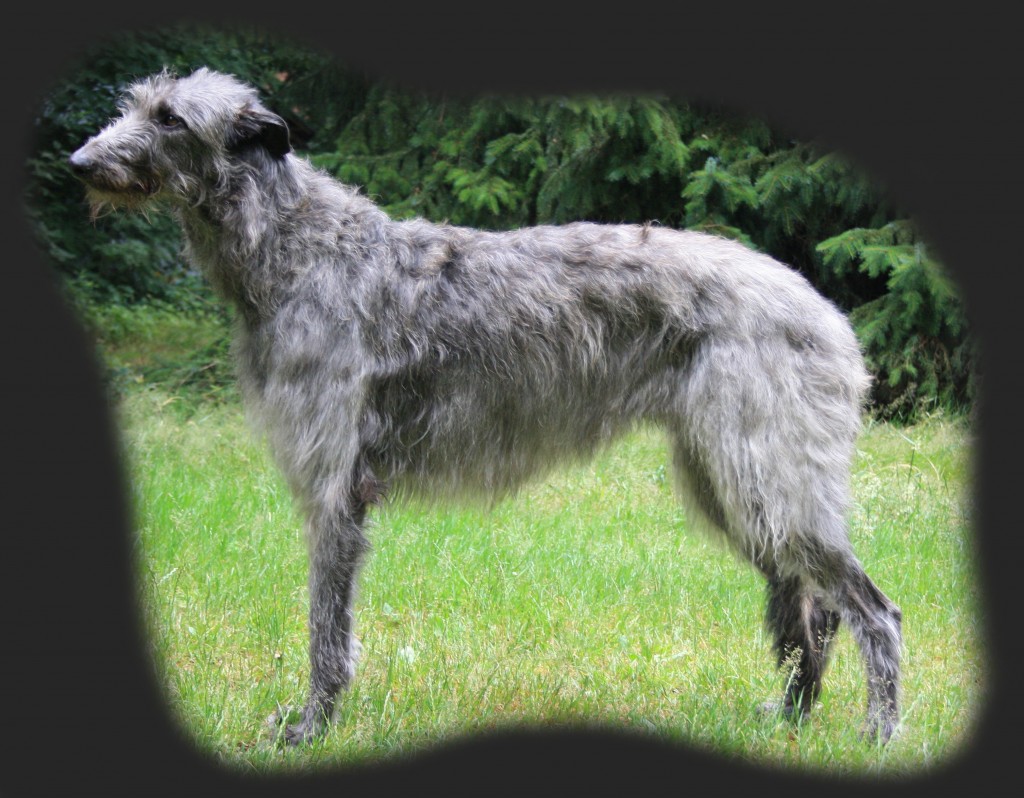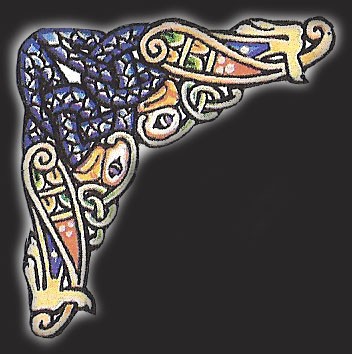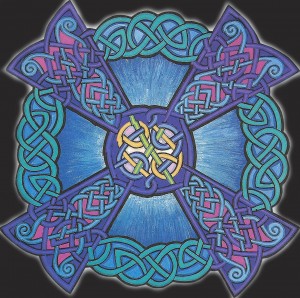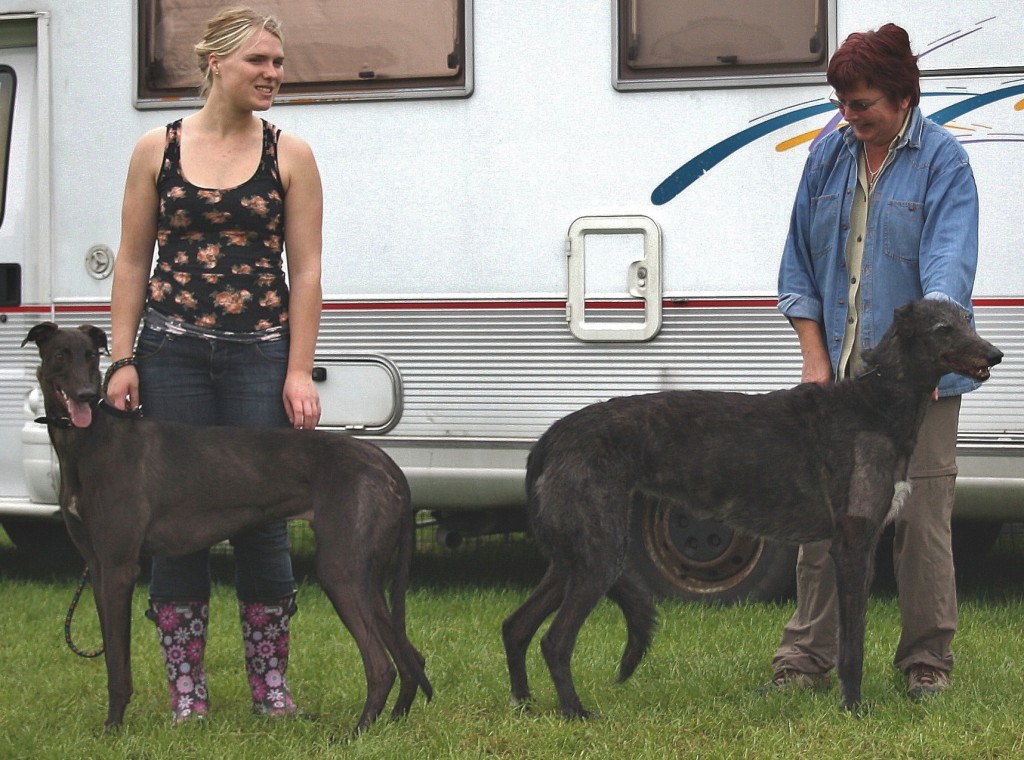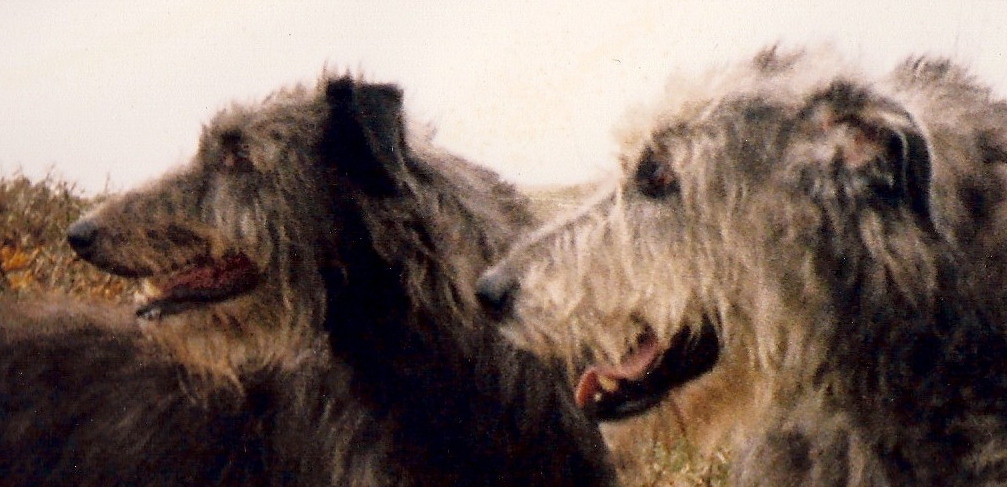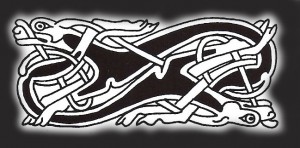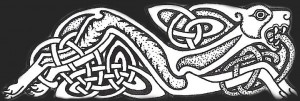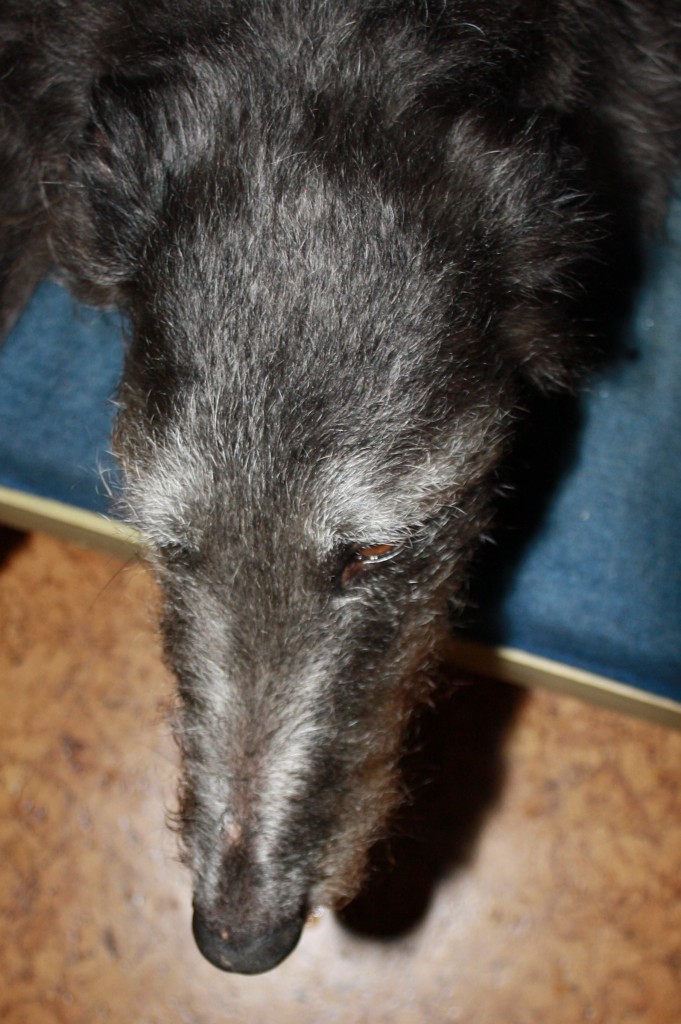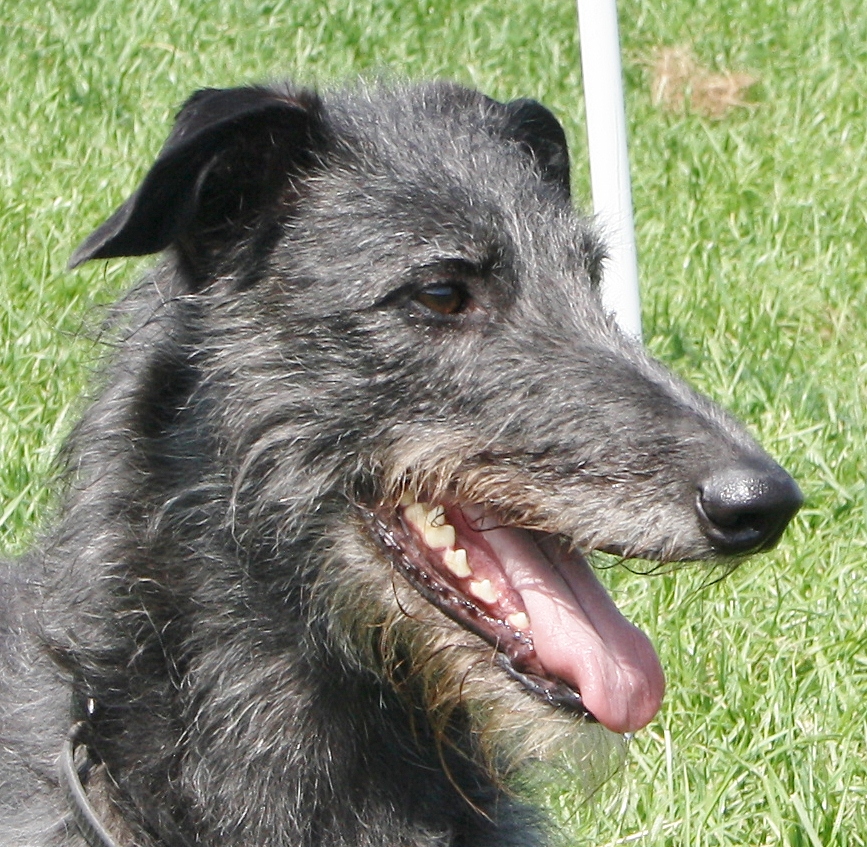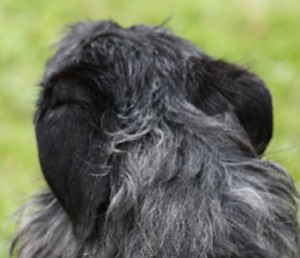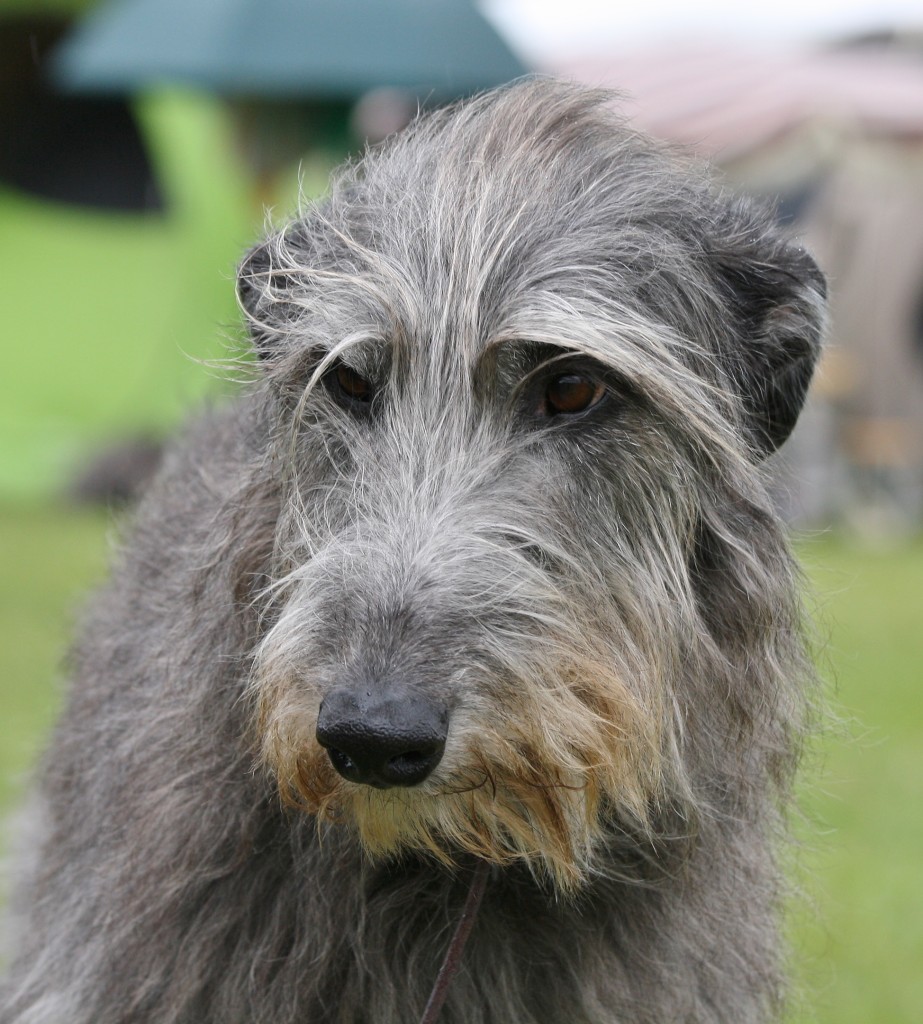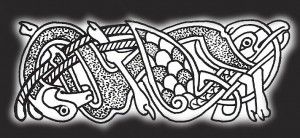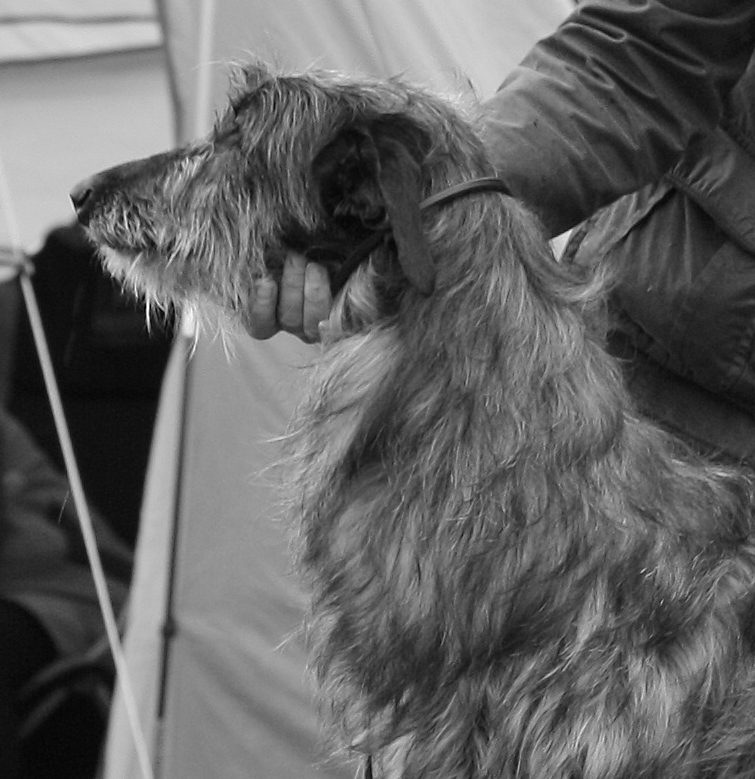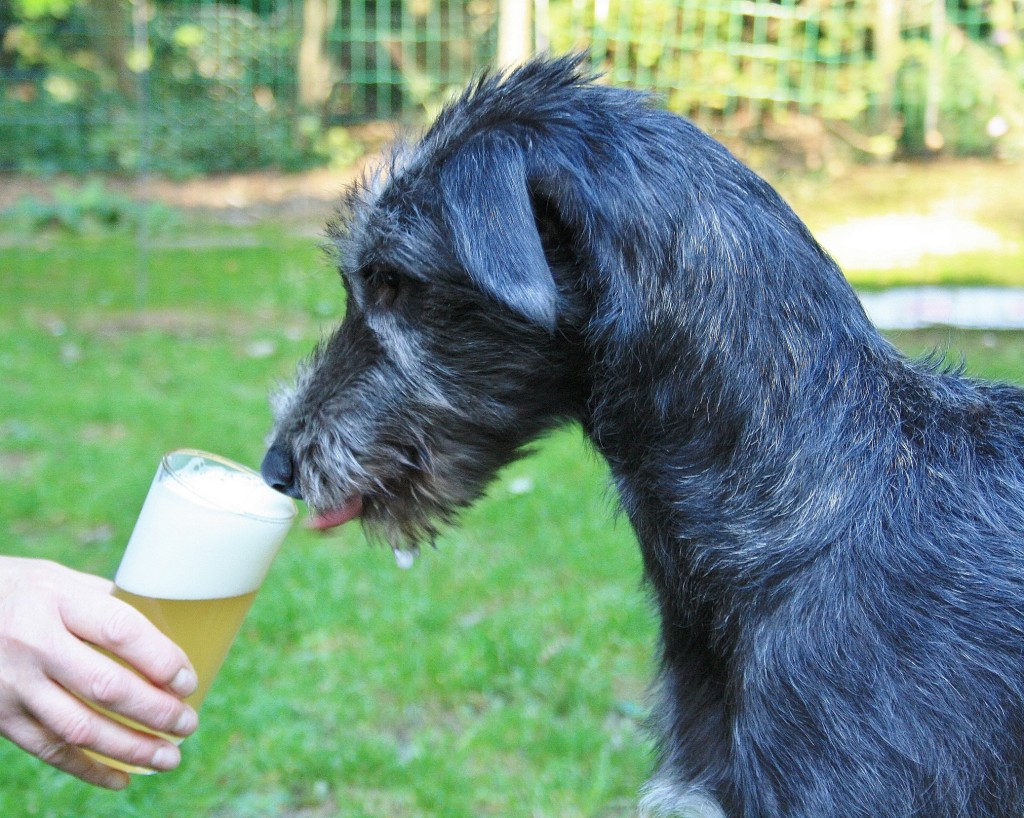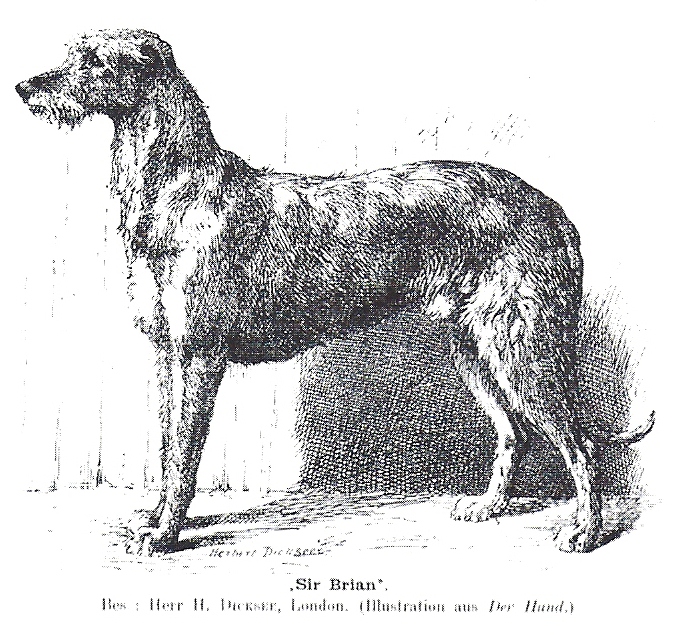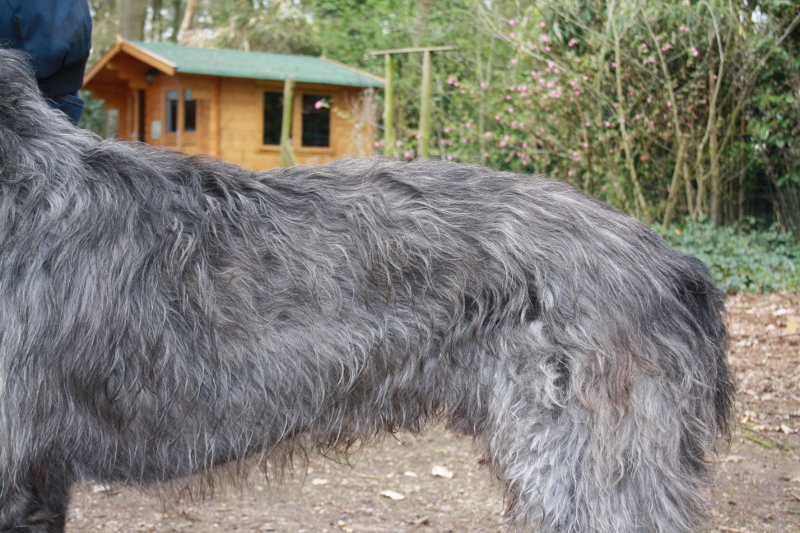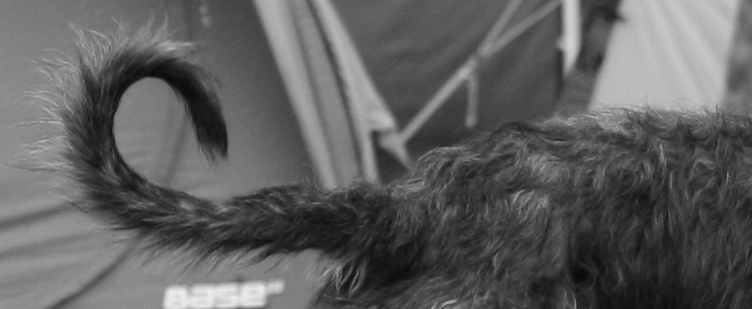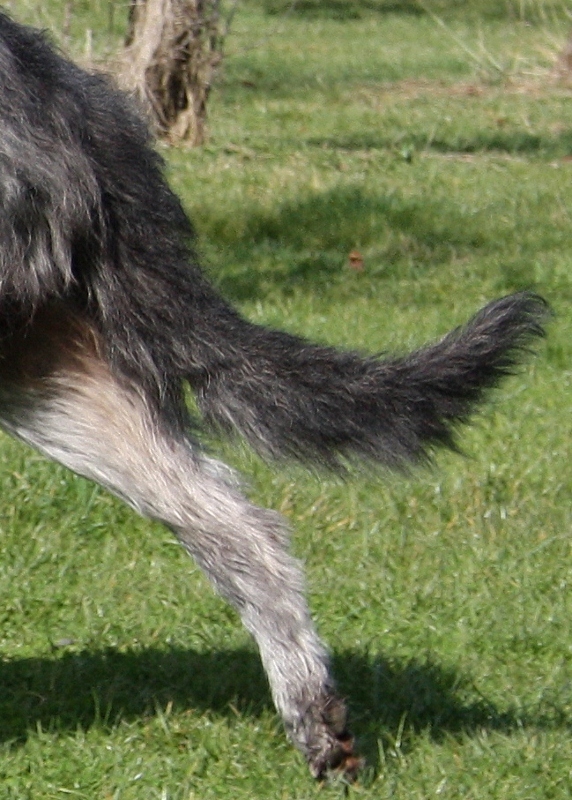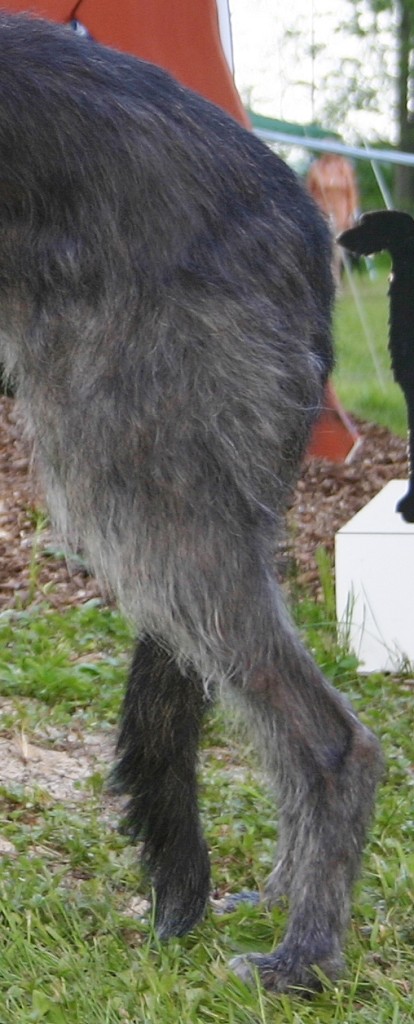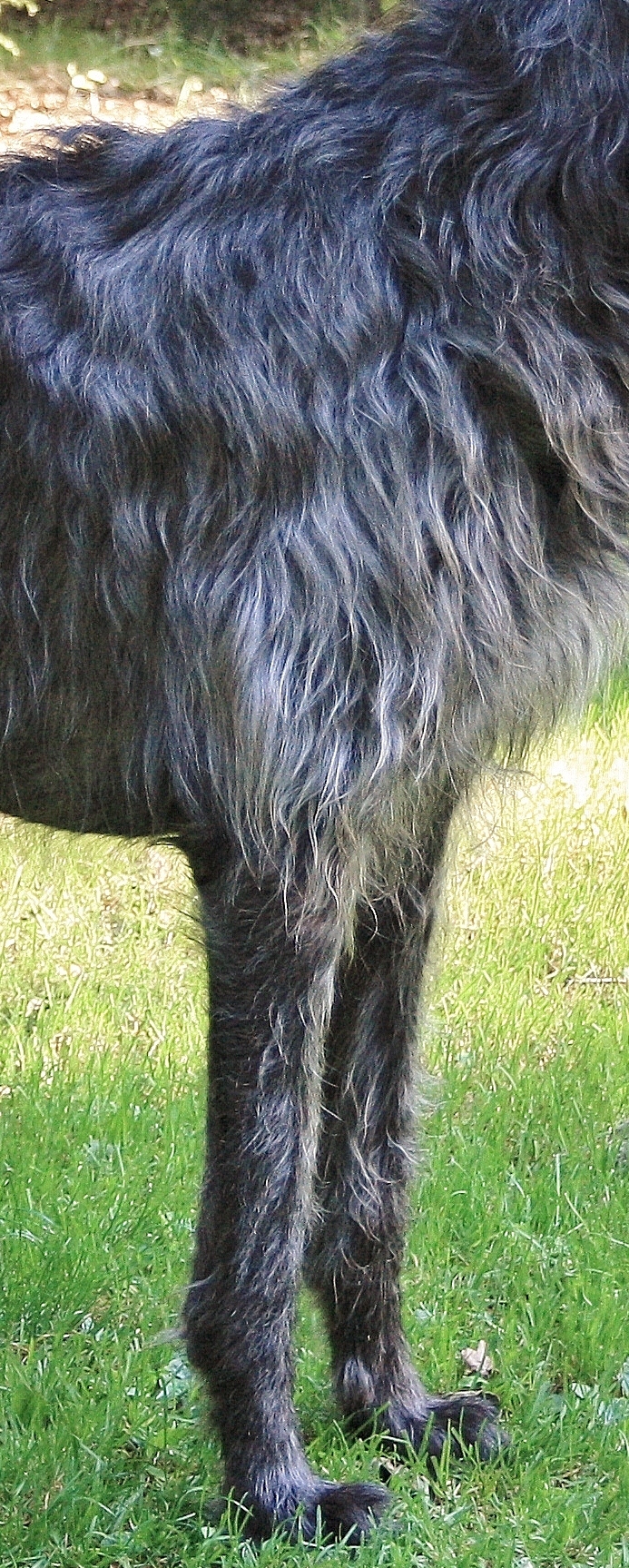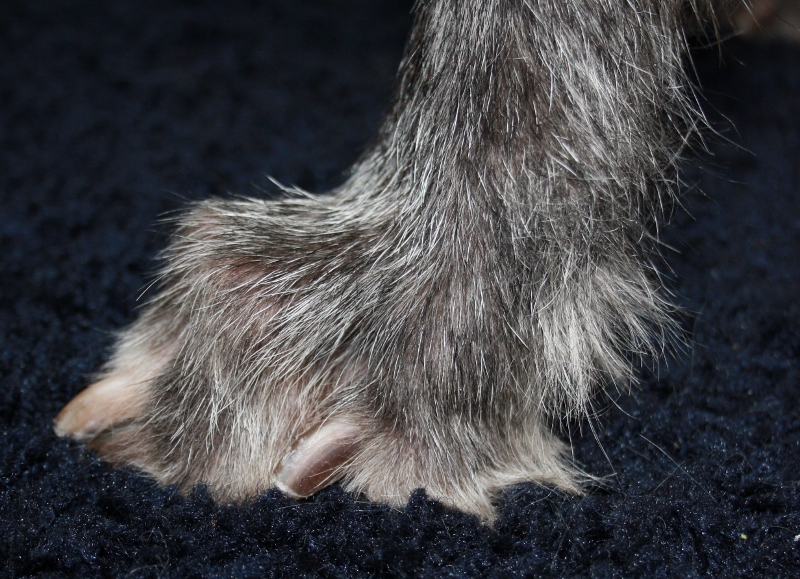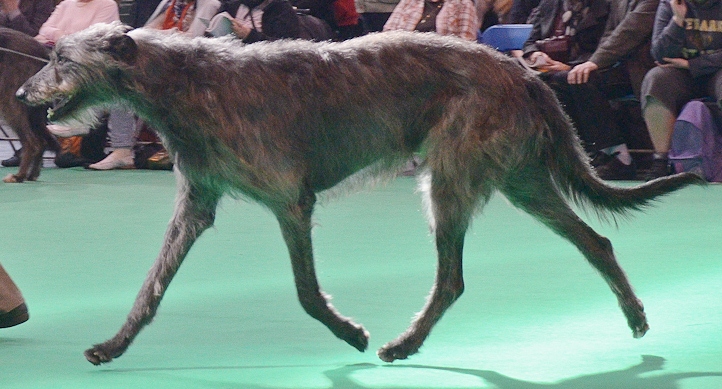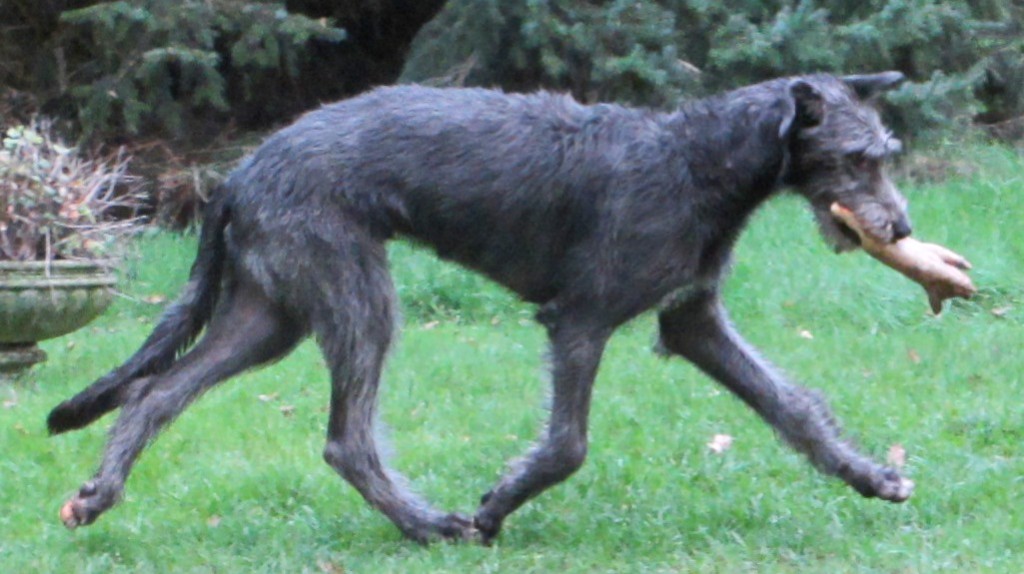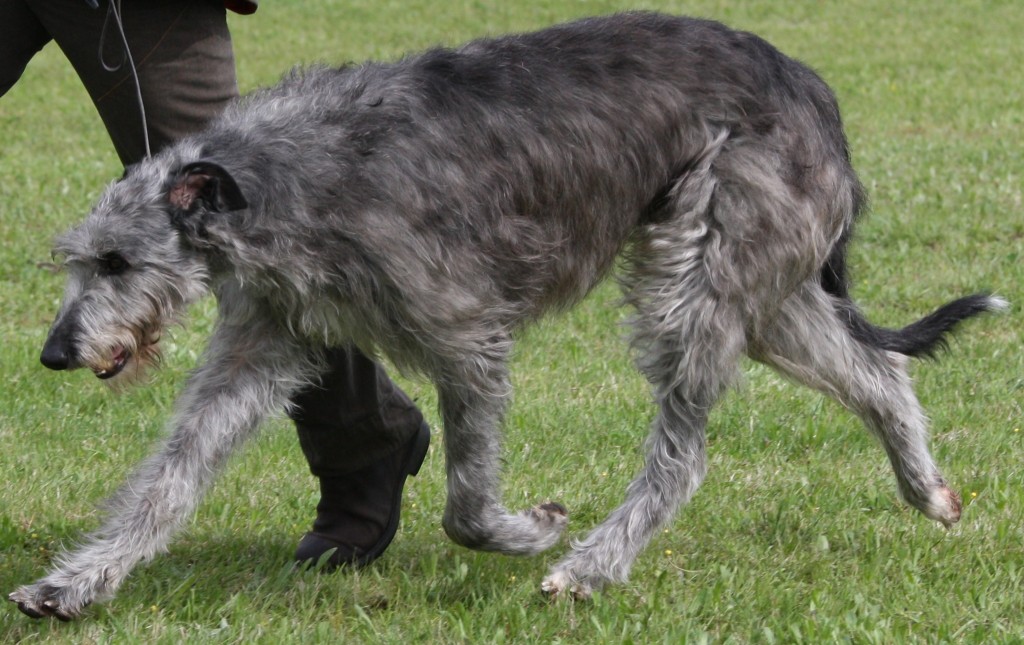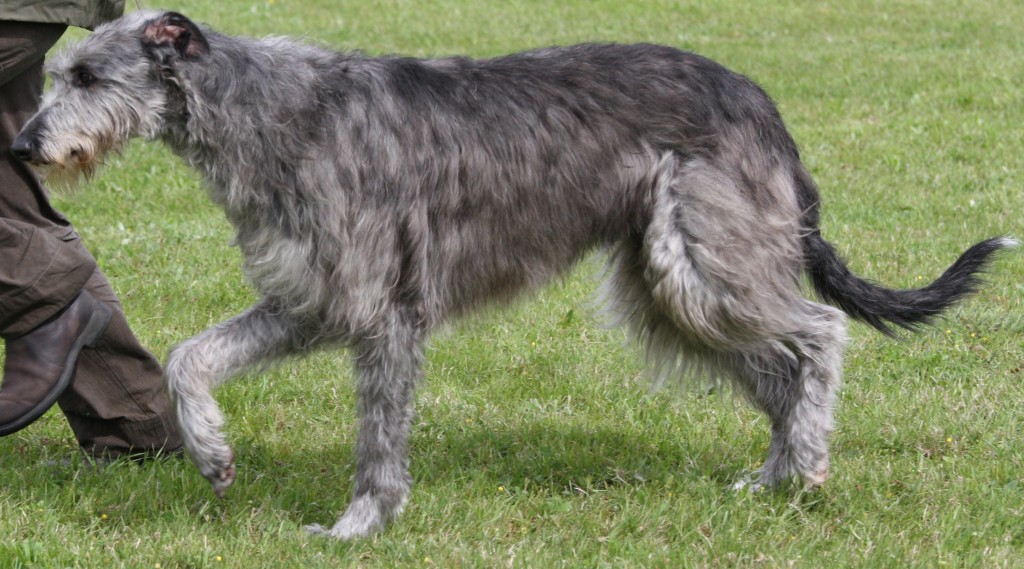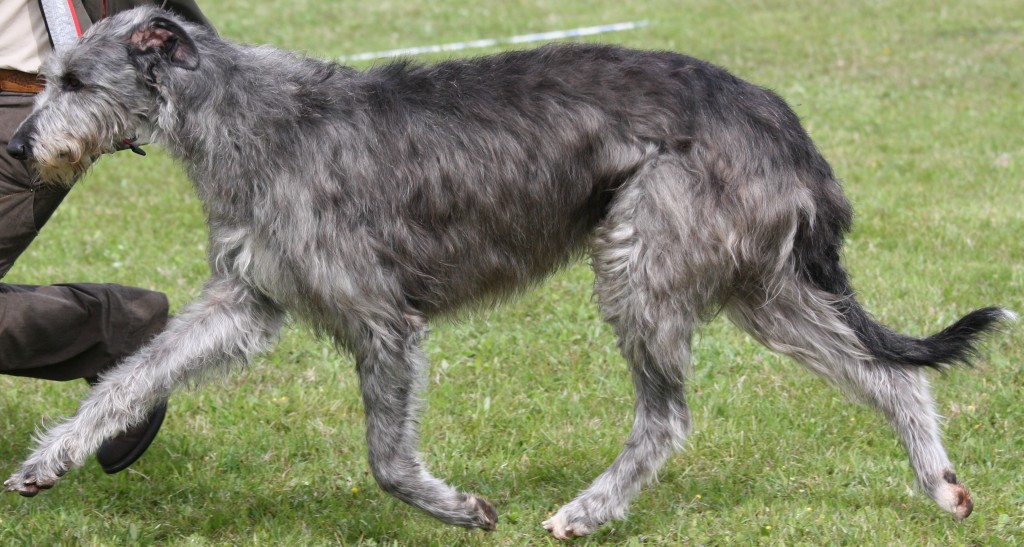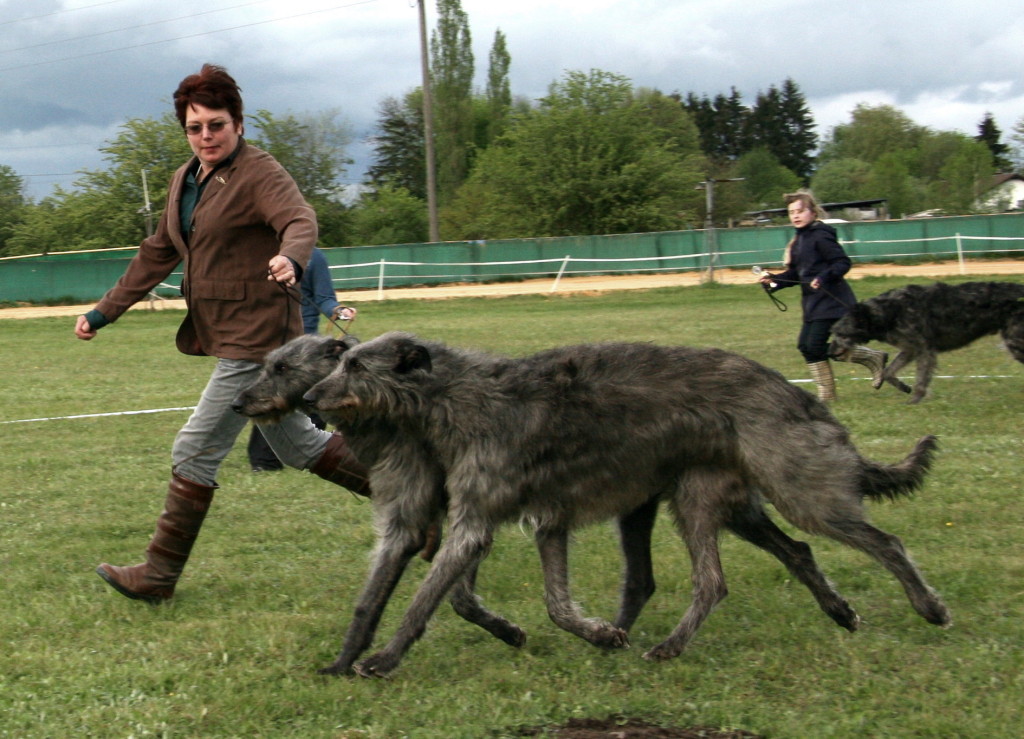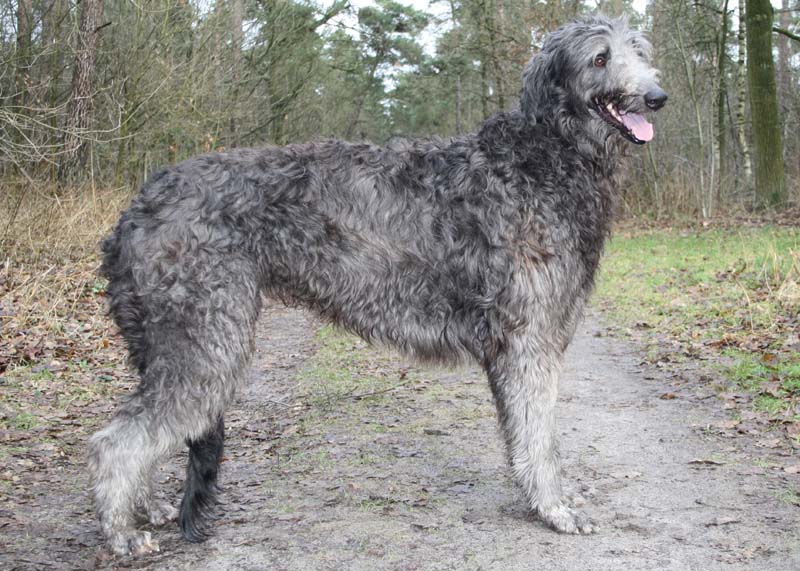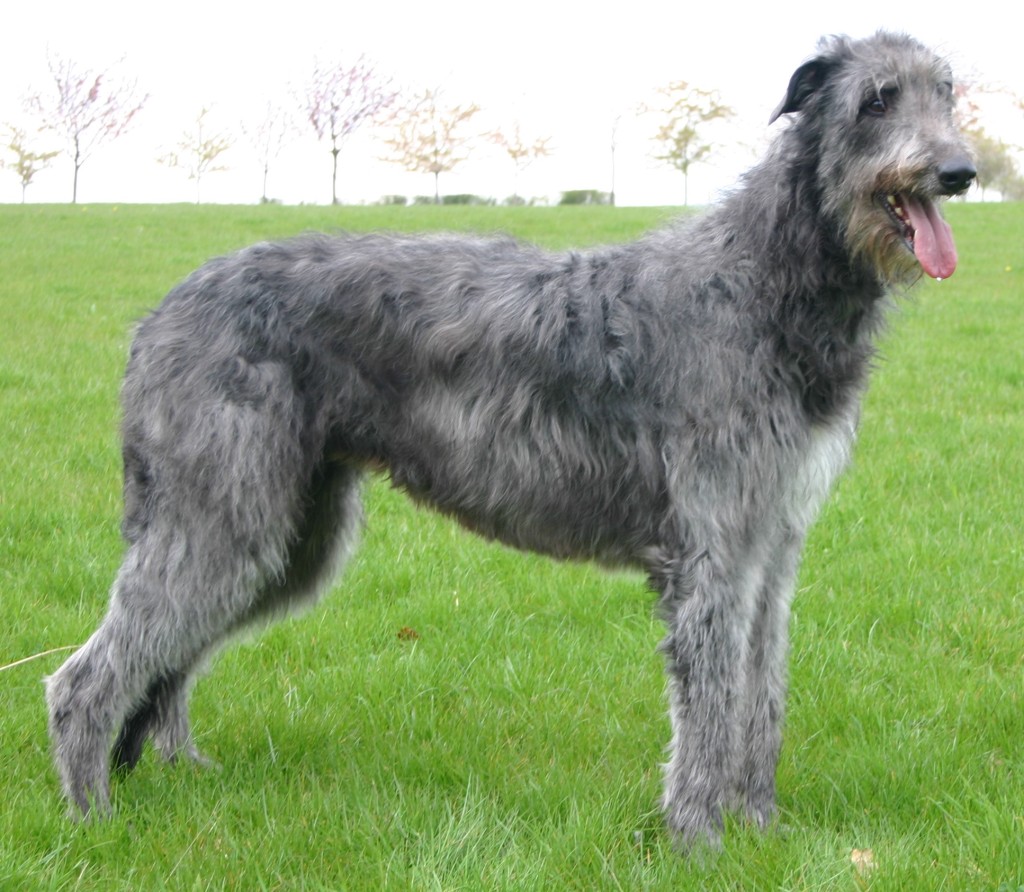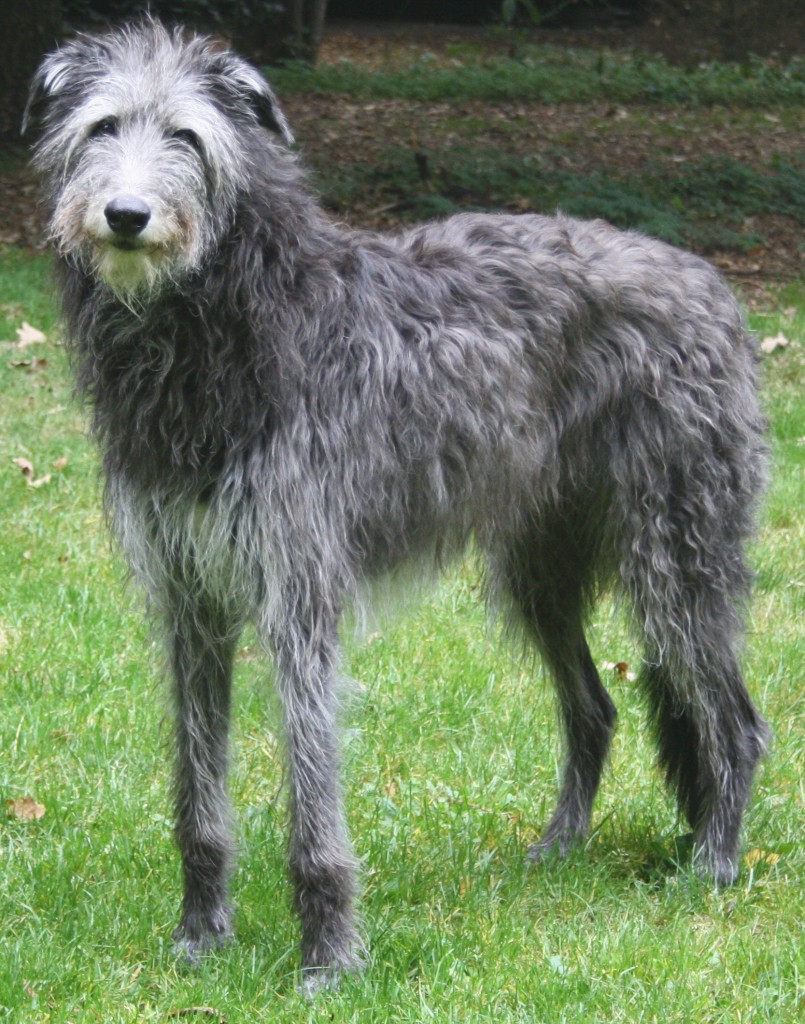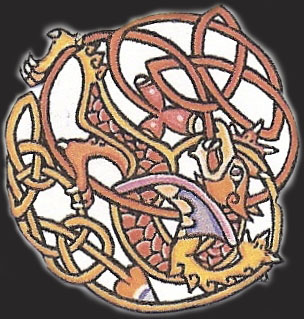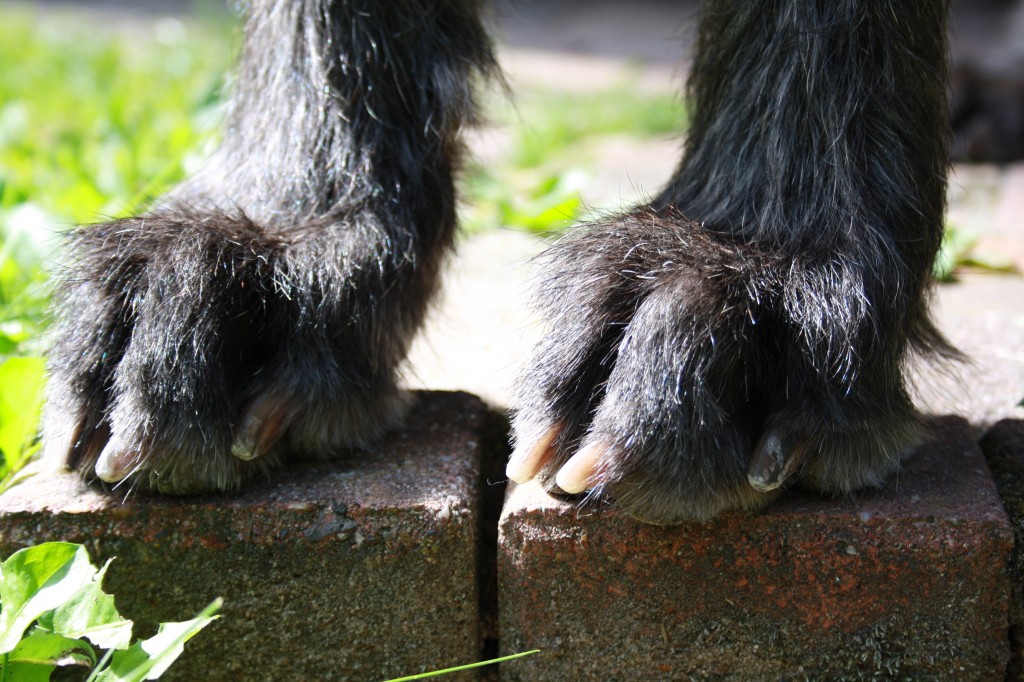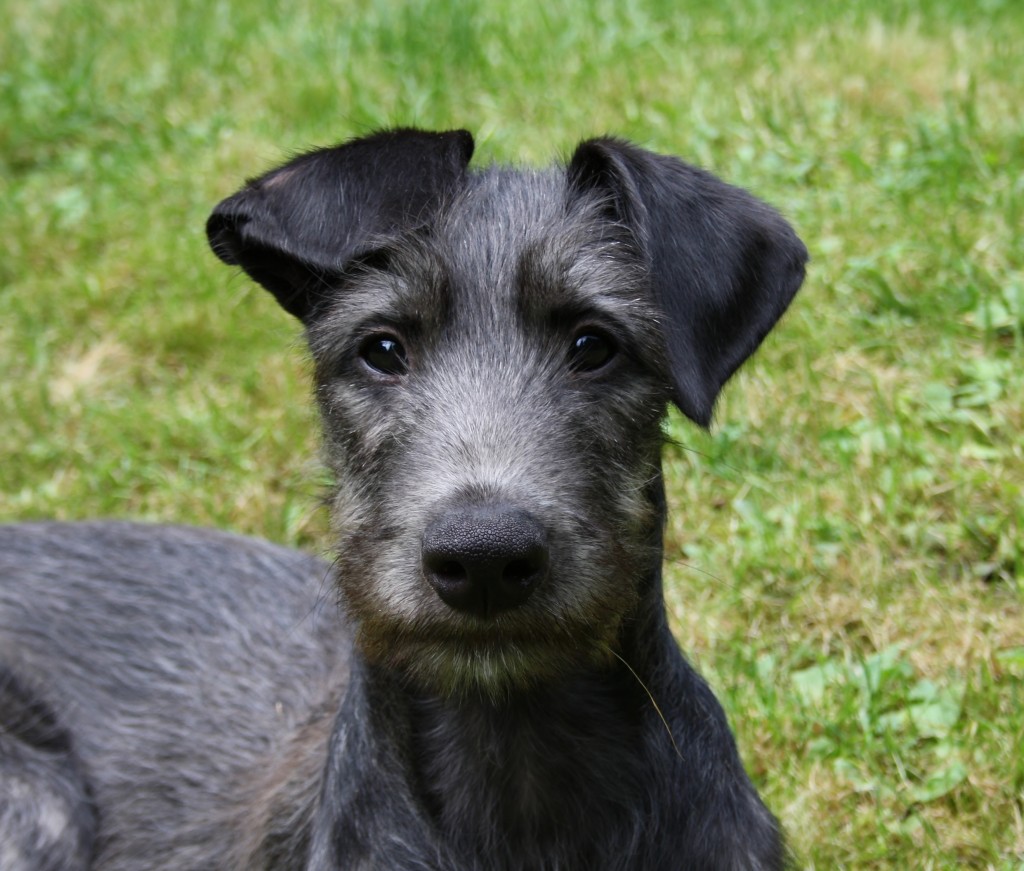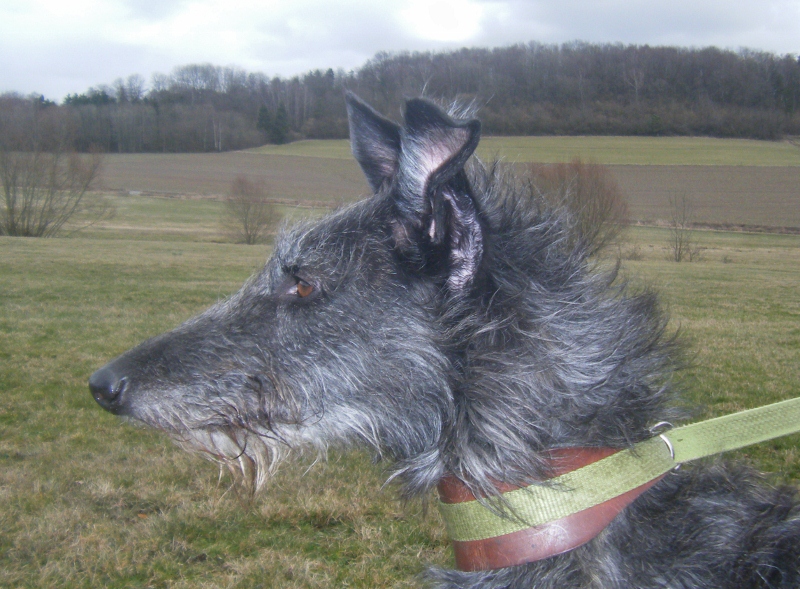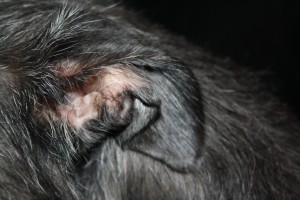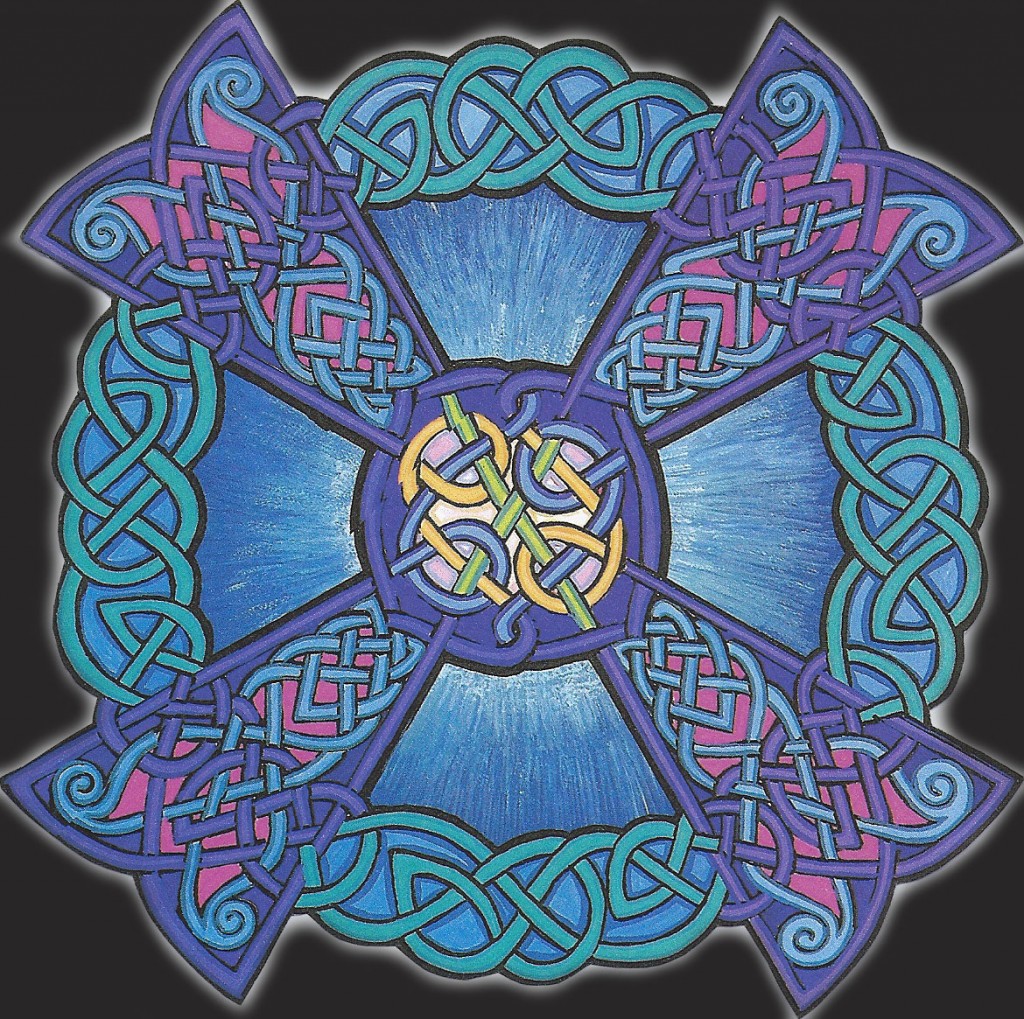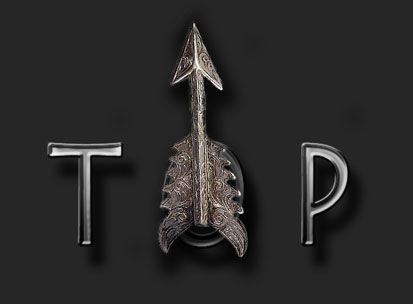 The Deerhound standard in word and image.
The Deerhound standard in word and image.
“A Most Perfect Creature of Heaven”
The Scottish Deerhound
“A most perfect creature of heaven…. Of the noblest Northern breed…. Deep in chest, strong in the stern, black colour, & brindled on chest & legs, not spotted with white, but just shaded into grey – strength to pull down a bull – swiftness to catch an antelope.
The Talisman, Sir Walter Scott.
To begin with, we must accept that the perfect Deerhound does not exist. But as a breeder you should strive to breed the perfect Deerhound and as a judge you should always keep looking for the perfect Deerhound. This means that you must try to give the best Deerhound an appropriate qualification. It can happen that you do not get higher than a Very Good (Continental judging system), simply because the (almost) perfect Deerhound is not in the ring. But what is “the” perfect Deerhound? That is different for everyone. Since the standard at most points leaves quite a bit of room for its own interpretation, there are many different types of Deerhounds. That has always been the case and that will always remain so. And that’s good, as long as they are within the standard. And that is what it is all about.
In a number of points, the standard is very clear and it is not so difficult to give an interpretation, but as a breeder and judge you need to know more than there is written in the standard. Therefore, it is also very important to have A: to study the old standards, B: to read what the “old” breeders, who still used the Deerhound for deer hunting, wrote about the breed and C: To see how a Deerhound chases/moves in the field. 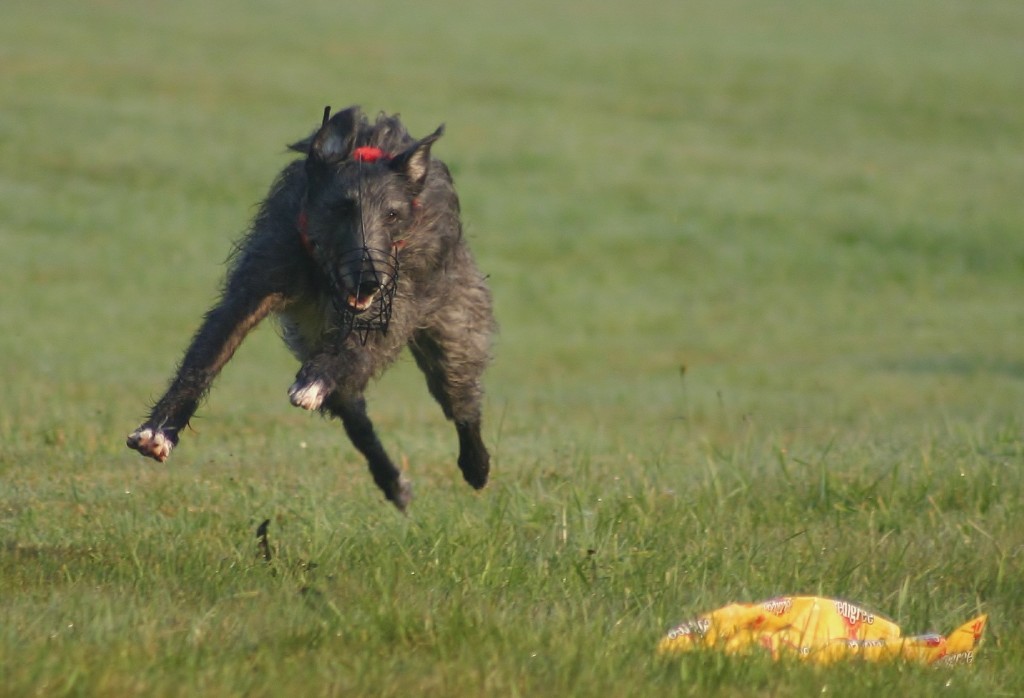 The current lure-coursing is of course not that for which the Deerhound is bred. It’s a fun game and one Deerhound takes it more seriously than the other. There are Deerhounds who absolutely do not go behind a plastic bag but perfectly hunt for real game and vice versa. But you can see very well during a coursing if the relevant hound can move well and is able to do that for which it was bred. I know many Deerhounds who trot fantastic in the show ring but cannot hunt at all but I know even more Deerhounds who are not trotting correctly but are very good hunters. This sits between the ears but… the not well-running hounds, if they have to hunt very regularly, will sooner or later have problems with the tendons and joints. Therefore you should strive for Deerhounds with a correct gait, good angles but not exaggerated, strong bone and powerful feet.
The current lure-coursing is of course not that for which the Deerhound is bred. It’s a fun game and one Deerhound takes it more seriously than the other. There are Deerhounds who absolutely do not go behind a plastic bag but perfectly hunt for real game and vice versa. But you can see very well during a coursing if the relevant hound can move well and is able to do that for which it was bred. I know many Deerhounds who trot fantastic in the show ring but cannot hunt at all but I know even more Deerhounds who are not trotting correctly but are very good hunters. This sits between the ears but… the not well-running hounds, if they have to hunt very regularly, will sooner or later have problems with the tendons and joints. Therefore you should strive for Deerhounds with a correct gait, good angles but not exaggerated, strong bone and powerful feet.
But the most important is TYPE. What is type? Miss Hartley described it as follows: “Type is the sum of those qualities which are distinctive to the breed, which make an animal not a dog but a Deerhound. It should never be forgotten that a crossbred or mongrol may have size, bone, substance, perfect feet and the soundest movement; but t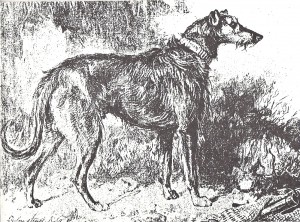 hese attributes, essentiel though they are, even all combined cannot make him a Deerhound. If you look at a Deerhound and the word wistful comes unbidden into your mind; if suddenly you seem to see a long vista of Deerhounds stretching away into the past, it is probable that the hound is typical”.
hese attributes, essentiel though they are, even all combined cannot make him a Deerhound. If you look at a Deerhound and the word wistful comes unbidden into your mind; if suddenly you seem to see a long vista of Deerhounds stretching away into the past, it is probable that the hound is typical”.
Before there were shows, the appearance was subordinate to the performance and the type was captured by the work capacities, there was an old Celtic rhyme to the Miol Chu, or so; “The Dog for hunting wild animals” to describe. It goes like this:
“An eye of sloe, with ear not low,
With horse’s breast, with depth of chest.
With breadth of loin, and curve in groin.
And nape set far behind the head:
Such were the dogs that Fingal bred. “
And the print of the Deerhound, pictured above, perfectly meets this rhyme! The first “official” description of the Deerhound was made by Messrs. Hickman and R. Hood Wright. It was approved on 26 November 1892 at a meeting of the Club and adopted in June 1901. This standard has been officially adopted by the English Kennel Club with one or two small additions in 1948.
In red I place the current standard, in blue the original standard. My comment is in white. Attached photos for clarification (hover the mouse over the picture and see the accompanying text, click on the picture and you will see a larger copy).
FCI-Standard No 164/05.12.2012/EN Deerhound
ORIGIN: Great Britain.
DATE OF PUBLICATION OF THE OFFICIAL VALID STANDARD: 08.10.2012
UTILIZATION: Racing dog, Hunting dog, companion.
FCI-CLASSIFICATION: Group 10-Sighthounds. Section 2-Rough-haired Sighthounds. Without working trial.
BRIEF HISTORICAL SUMMARY: The Deerhound, known at one time as the Scottish Deerhound, has mystery surrounding his origins, but there are grounds for thinking the Deerhound may have been introduced to Scotland by Phoenician traders. Certainly there were running hounds there when the Romans arrived. The breed has hunted the red deer for a thousand years, and although today more accustomed to the show ring, he has remaind similar in type over the centuries.
GENERAL APPEARANCE: Resembles a rough-coated greyhound of larger size and bone.
This is a very important point. A Deerhound is not a big wirehaired Greyhound, he just has to look like it. He must have the long lines of the Greyhound and not be built squarely. He shouldn’t have the long neck of the greyhound because he doesn’t have to pick up his prey from the ground like the greyhound. If the Deerhound had just such a long neck as the Greyhound, this would be far too fragile in the deer hunt. Also the Deerhound has more arch over the loin, a slightly more drooping croup and slightly more angulation in the backhand than the Greyhound, this because it is necessary for working in the hills. Also the Deerhound does not have to resemble an Irish Wolfhound. The head is totally different: The Irish Wolfhound has a block head, the Deerhound a conical head (seen from above) like the Greyhound. If an Irish Wolfhound and a Deerhound come simultaneously around the corner of a door, you can once the noses appear, see who is who. The nose of the Deerhound is much more pointed and therefore extends for his jaws. The Irish Wolfhound is much heavier in construction, more spring of rib, a little less arch over the loin and less elegant.
BEHAVIOUR/TEMPERAMENT: The build suggests the unique combination of speed, power and endurance necessary to pull down a stag, but general bearing is one of gentle dignity. Gentle and friendly. Obedient and easy to train because eager to please. Docile Peter Schrijvers and good tempered, never suspicious, aggressive or nervous. Carries himself with quiet dignity.
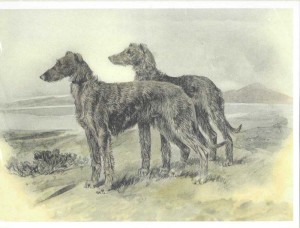 The character of the Deerhound is very special. They are extremely soft and sensitive. Also very young puppies feel very quickly what mood is in the house and when you spend a lot of time with them they learn everything very quickly. We enthusiasts always say that a Deerhound is not a dog, the Deerhound is somewhere between dog and man. They also do not behave like dogs and look down on dogs that bark and are aggressive. A young male must be guided in his behavior towards other males during his puberty, but correcting it once when he growls usually ensures that he knows how to behave properly for the rest of his life. I have never had any problems with males and/or bitches. I always have several of both sexes at the same time and even during the bitches’ seasons the males don’t argue while they all just stay in the house. I always think that the harder you do yourself the harder the hounds become. In any case, aggression is absolutely intolerable, in no circumstance! Also fear and nervousness should absolutely not occur in the Deerhound.
The character of the Deerhound is very special. They are extremely soft and sensitive. Also very young puppies feel very quickly what mood is in the house and when you spend a lot of time with them they learn everything very quickly. We enthusiasts always say that a Deerhound is not a dog, the Deerhound is somewhere between dog and man. They also do not behave like dogs and look down on dogs that bark and are aggressive. A young male must be guided in his behavior towards other males during his puberty, but correcting it once when he growls usually ensures that he knows how to behave properly for the rest of his life. I have never had any problems with males and/or bitches. I always have several of both sexes at the same time and even during the bitches’ seasons the males don’t argue while they all just stay in the house. I always think that the harder you do yourself the harder the hounds become. In any case, aggression is absolutely intolerable, in no circumstance! Also fear and nervousness should absolutely not occur in the Deerhound.
CRANIAL REGION: SKULL: Flat rather than round, with very slight rise over eyes. Broadest at ears, tape ring slightly to eyes. Skull coated with moderately long hair, softer than rest of coat. STOP: No stop.
FACIAL REGION: NOSE: Slightly aquiline and Black. MUZZLE: Tape ring more decidedly to nose. In Lighter coloured dogs black muzzle preferred. LIPS: Level. Good moustache of rather silky hair and some beard. JAWS/TEETH: Jaws strong, with a perfect, regular and complete scissor bite, i.e. the upper tee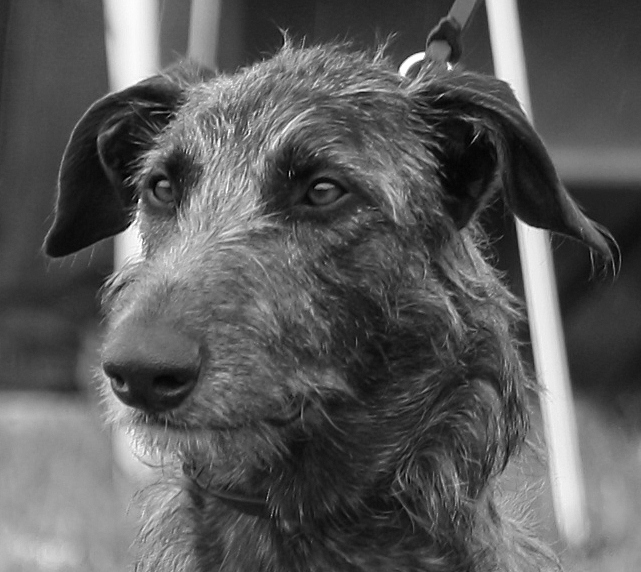 th closely overlap the lower teeth and set square to the Jaws. EYES: Dark. Gene rally dark brown or hazel. Light eyes undesirable. Moderately full with a soft look in repose, but keen, far-away look when dog is roused. Rims Black. EARS: Set on high and in repose folded back. In excitment raised above head without losing the fold and in some cases semi-erect. A big thick ear hanging flat to the head or a prick ear most undesirable. Ear soft, glossy and like a mouse’s coat to the touch; The smaller the better, no long coat or fringe. Ears black or dark coloured.
th closely overlap the lower teeth and set square to the Jaws. EYES: Dark. Gene rally dark brown or hazel. Light eyes undesirable. Moderately full with a soft look in repose, but keen, far-away look when dog is roused. Rims Black. EARS: Set on high and in repose folded back. In excitment raised above head without losing the fold and in some cases semi-erect. A big thick ear hanging flat to the head or a prick ear most undesirable. Ear soft, glossy and like a mouse’s coat to the touch; The smaller the better, no long coat or fringe. Ears black or dark coloured.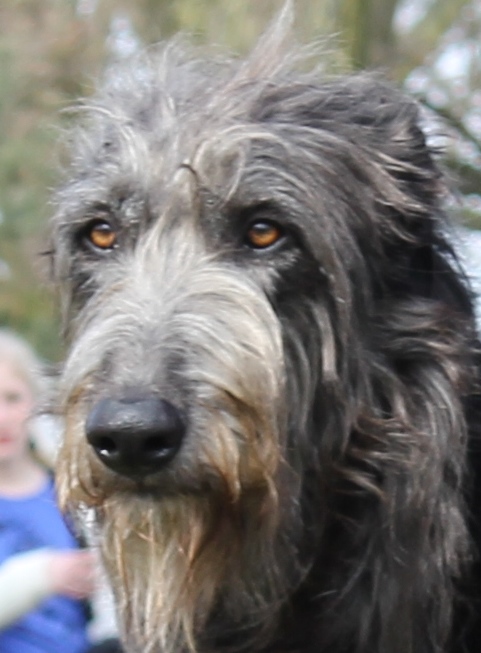
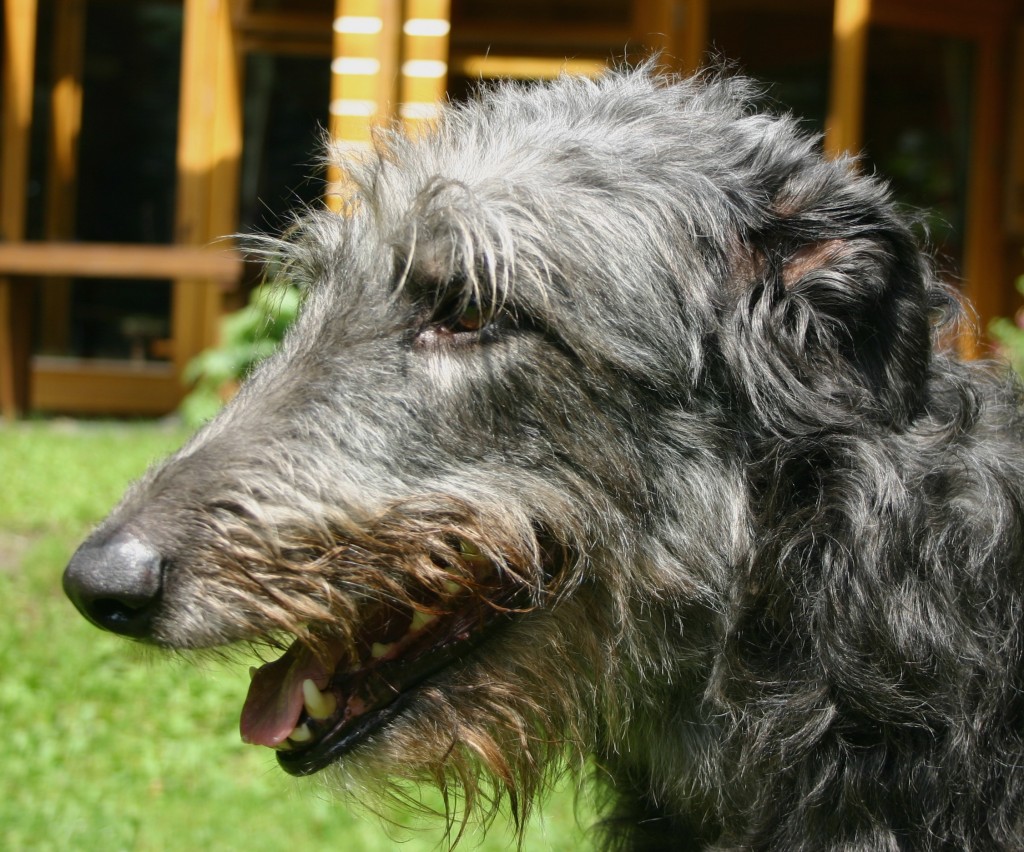 STANDARD OF POINTS. Head AND SKULL: The head should be broadest at the ears, tape ring slightly to the eyes, with the muzzle tape ring more decidedly to the nose. The muzzle should be pointed but the lips level. The head should be long, the skull rather flat than round, with a very slight rise over the eyes, but with nothing approaching a stop. The skull should be coated with moderately long hair, which is softer than the rest of the coat. The nose should be black (though in some blue-fawns the colour is blue) and slightly aquiline. In The lighter coloured dogs a
STANDARD OF POINTS. Head AND SKULL: The head should be broadest at the ears, tape ring slightly to the eyes, with the muzzle tape ring more decidedly to the nose. The muzzle should be pointed but the lips level. The head should be long, the skull rather flat than round, with a very slight rise over the eyes, but with nothing approaching a stop. The skull should be coated with moderately long hair, which is softer than the rest of the coat. The nose should be black (though in some blue-fawns the colour is blue) and slightly aquiline. In The lighter coloured dogs a 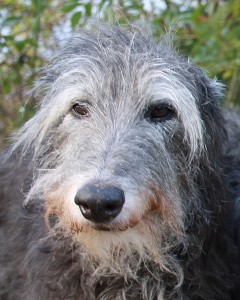 black muzzle is preferred. There should be a good moustache of rather silky hair and a fair beard. Eyes: The eyes should be dark; Gene rally They are dark-brown or hazel. A very light eye is not liked. The eye is moderately full, with a soft look in repose, but a keen, far-away look when the dog is roused. The rims of the eyelids should be black. Ears: The ears should be set on high, and, in repose, folded back like the Greyhound’s, though raised above The head in excitation without losing the fold, and even in some cases semi-erect. A
black muzzle is preferred. There should be a good moustache of rather silky hair and a fair beard. Eyes: The eyes should be dark; Gene rally They are dark-brown or hazel. A very light eye is not liked. The eye is moderately full, with a soft look in repose, but a keen, far-away look when the dog is roused. The rims of the eyelids should be black. Ears: The ears should be set on high, and, in repose, folded back like the Greyhound’s, though raised above The head in excitation without losing the fold, and even in some cases semi-erect. A prick ear is bad. A big thick ear hanging flat to the head, or heavily coated with long hair, is the sausage of faults. The ear should be soft, glossy, and like a mouse’s coat to the touch, and the smaller it is the better. It should have no long coat or long fringe, but there is often a silky silvery coat on the body of the ear and the tip. Whatever the general colour, the ears should be black or dark-coloured. MOUTH: Teeth Level.
prick ear is bad. A big thick ear hanging flat to the head, or heavily coated with long hair, is the sausage of faults. The ear should be soft, glossy, and like a mouse’s coat to the touch, and the smaller it is the better. It should have no long coat or long fringe, but there is often a silky silvery coat on the body of the ear and the tip. Whatever the general colour, the ears should be black or dark-coloured. MOUTH: Teeth Level.
Nowaday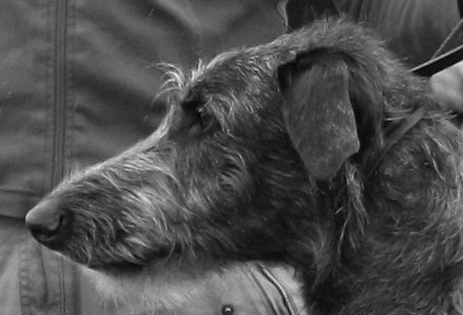 s we see quite a few “ugly” heads. This is usually caused by light eyes, too little pigment, too large and/or not well folded ears and/or no parallelism. The latter is not in the standard but is indeed important for the correct type of head. We also see heads lately with too much stop and/or too high forehead and/or a too highly developed occiput (occipital). We also see heads that are too fine. One must always keep in mind that the Deerhound must be able to hold and take down a deer with its jaws, so these must be strong. But a Deerhound must have absolutely not have big cheeks. Many Deerhounds show in the show ring a low set ear. This is by disinterest. If something happens, you will see that the ear (usually) is in the right place. The furnishing can be a discussion point but when we look at the old prints of Deerhounds then we see that they had little furnishing at the time. They talk of a good mustache, some beard and moderately long hair on the head. Too much is not functional and too little give
s we see quite a few “ugly” heads. This is usually caused by light eyes, too little pigment, too large and/or not well folded ears and/or no parallelism. The latter is not in the standard but is indeed important for the correct type of head. We also see heads lately with too much stop and/or too high forehead and/or a too highly developed occiput (occipital). We also see heads that are too fine. One must always keep in mind that the Deerhound must be able to hold and take down a deer with its jaws, so these must be strong. But a Deerhound must have absolutely not have big cheeks. Many Deerhounds show in the show ring a low set ear. This is by disinterest. If something happens, you will see that the ear (usually) is in the right place. The furnishing can be a discussion point but when we look at the old prints of Deerhounds then we see that they had little furnishing at the time. They talk of a good mustache, some beard and moderately long hair on the head. Too much is not functional and too little give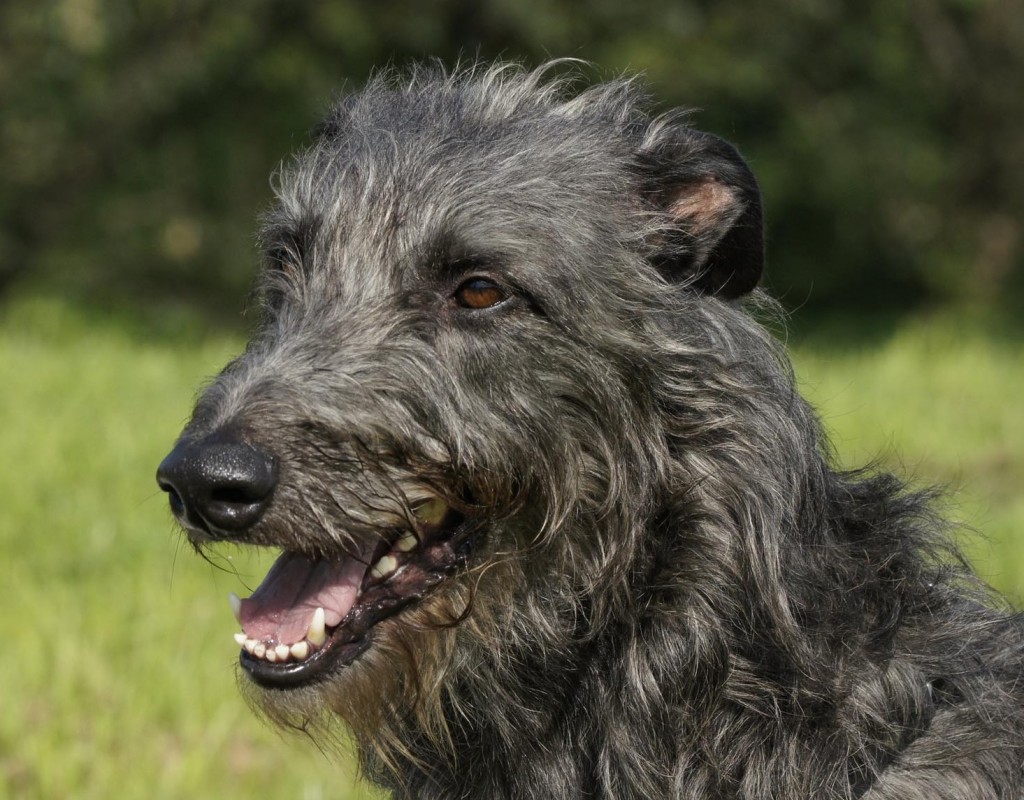 s type-loss. It is very important that the nobility is dripping from the head. This is accomplished by correct, almost parallel nose-skull lines, the slightly bent nose (no rams ‘ nose!), beautiful small, high-set and well-folded ears, a beautiful dark eye surrounded by well-pigmented (black) eyelids and a noble attitude by a strong “nape”.
s type-loss. It is very important that the nobility is dripping from the head. This is accomplished by correct, almost parallel nose-skull lines, the slightly bent nose (no rams ‘ nose!), beautiful small, high-set and well-folded ears, a beautiful dark eye surrounded by well-pigmented (black) eyelids and a noble attitude by a strong “nape”.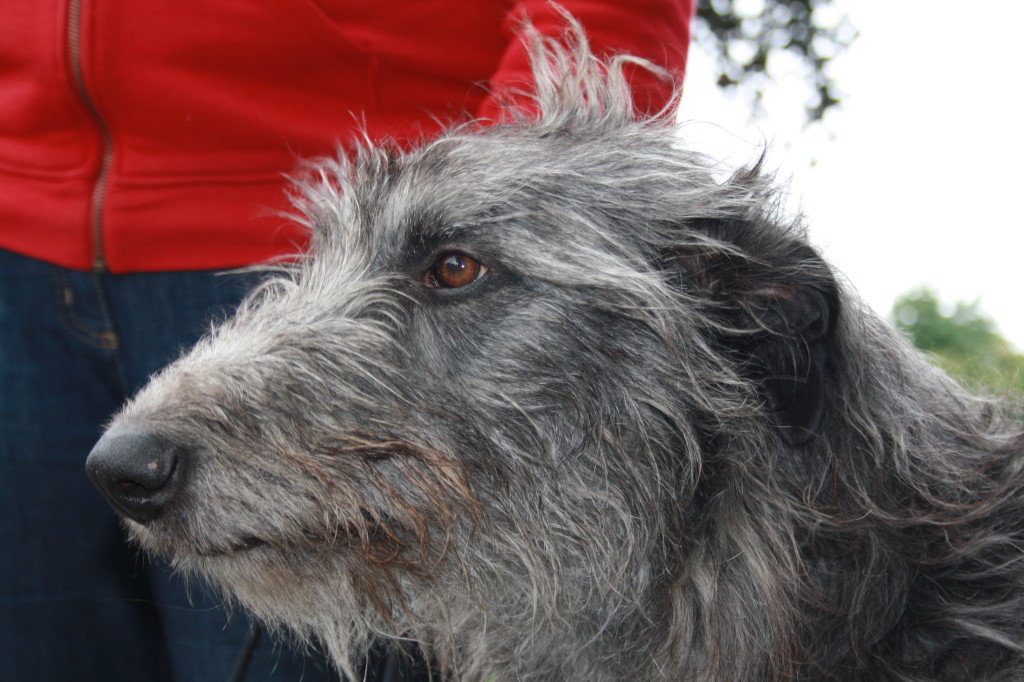
NECK: Very strong with good reach sometimes disguised by mane. Nape of neck very prominent where head is set on, no throatiness.
Neck: The neck should be long: that is, of the length that befits the Greyhound character of t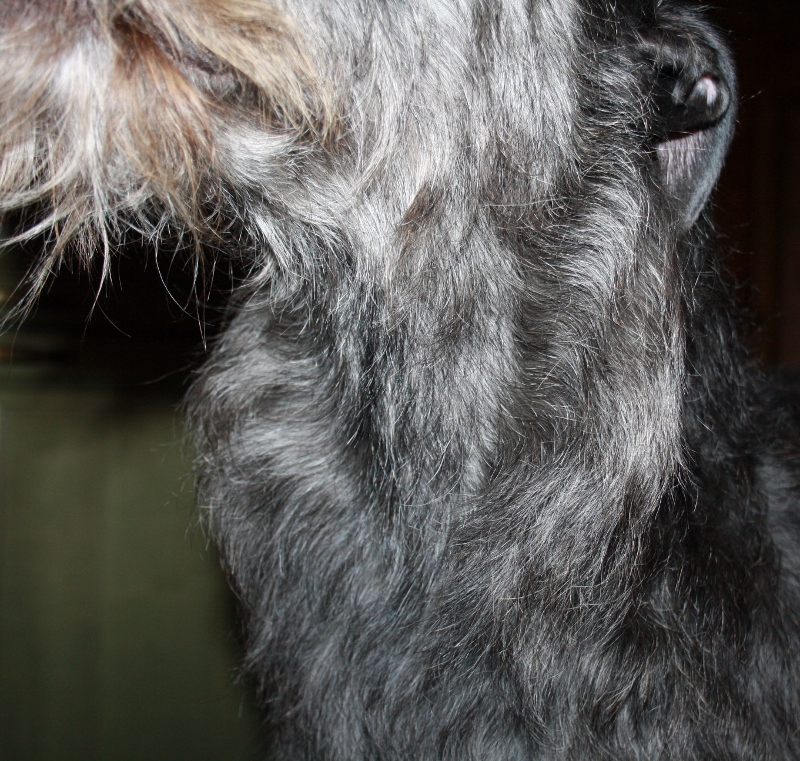 he dog. An over-long neck is not necessary or desirable, for the dog is not required to stoop to his work like a Greyhound, and it must be remembered that the mane, which every good specimen should have, detracts from the apparent length of neck. Moreover, a Deerhound requires a very strong neck to hold a stag. The nape of the neck should be very prominent where the head is set on, and the throat should be clean cut at the angle and prominent.
he dog. An over-long neck is not necessary or desirable, for the dog is not required to stoop to his work like a Greyhound, and it must be remembered that the mane, which every good specimen should have, detracts from the apparent length of neck. Moreover, a Deerhound requires a very strong neck to hold a stag. The nape of the neck should be very prominent where the head is set on, and the throat should be clean cut at the angle and prominent.
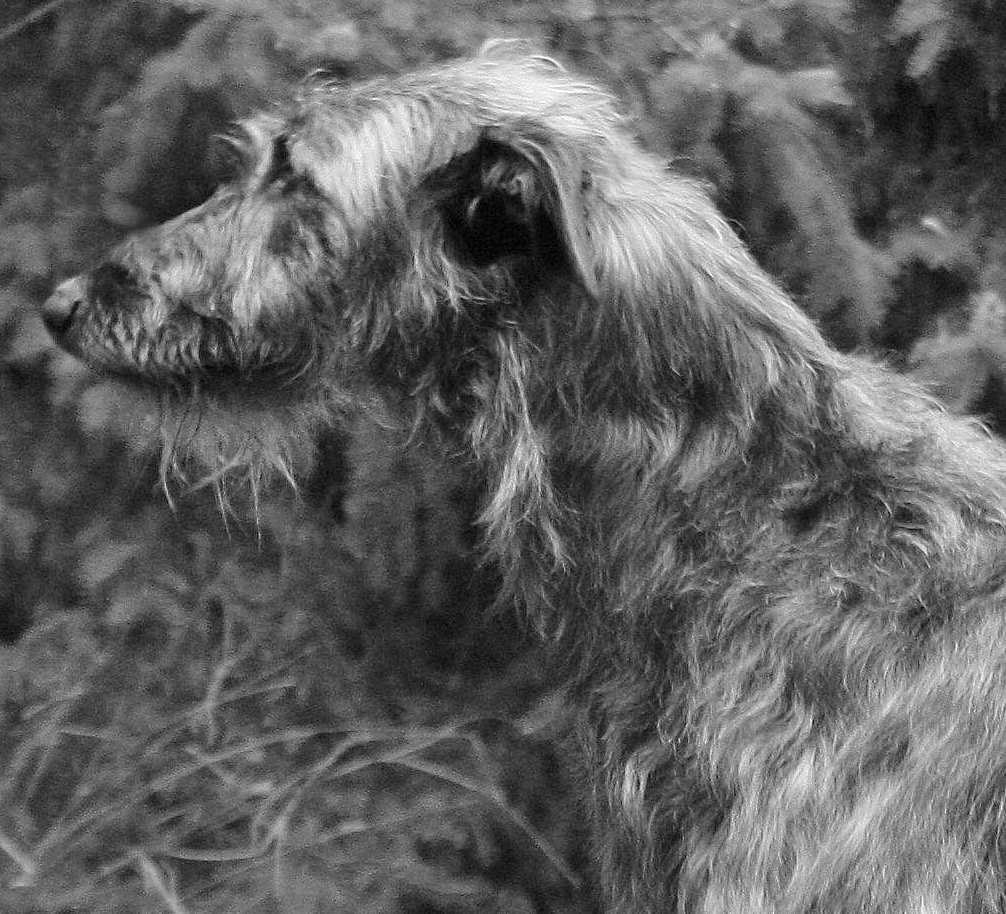 The neck of a Deerhound must be extremely powerful, which is best described in the old Standard (blue). When you go with your hand over the skull towards the neck, you will feel immediately behind the occiput a little “dent” with a strong curve, the “nape”,
The neck of a Deerhound must be extremely powerful, which is best described in the old Standard (blue). When you go with your hand over the skull towards the neck, you will feel immediately behind the occiput a little “dent” with a strong curve, the “nape”, 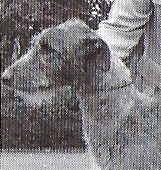 but the rest of the neck must also be powerful! He must clearly widen to the withers so that a nice smooth transition to the back is made.
but the rest of the neck must also be powerful! He must clearly widen to the withers so that a nice smooth transition to the back is made.
The beautiful mane, like a beautiful tail, is an ornament for the Deerhound.
BODY: Body and general formation that of a greyhound of larger size and bone. BACK: Flat line undesirable. LO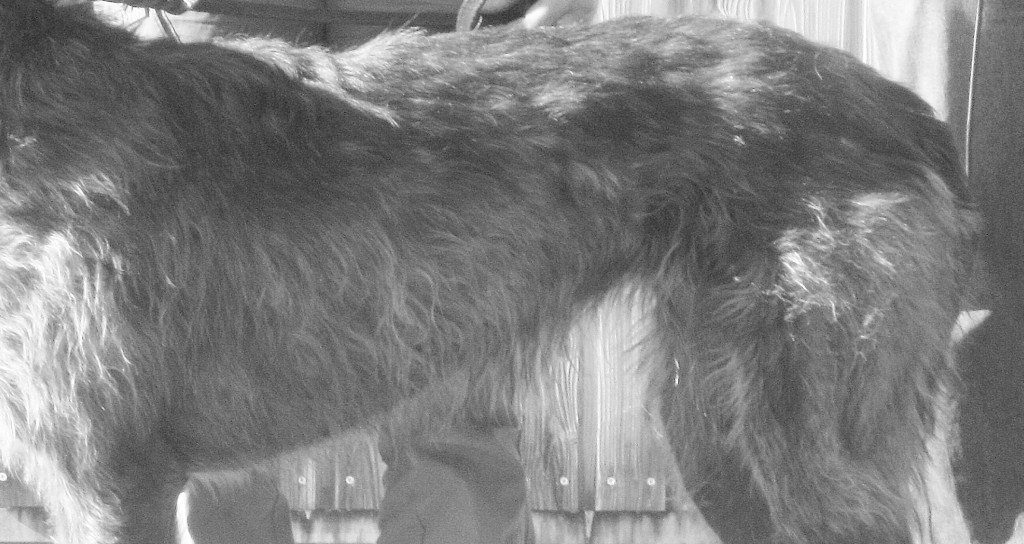 IN: Well arched and drooping to tail. CROUP: Drooping, Broad and powerful. Hipbones set wide apart. CHEST: Deep rather than broad, not too narrow and flat-sided.
IN: Well arched and drooping to tail. CROUP: Drooping, Broad and powerful. Hipbones set wide apart. CHEST: Deep rather than broad, not too narrow and flat-sided.
Body: The b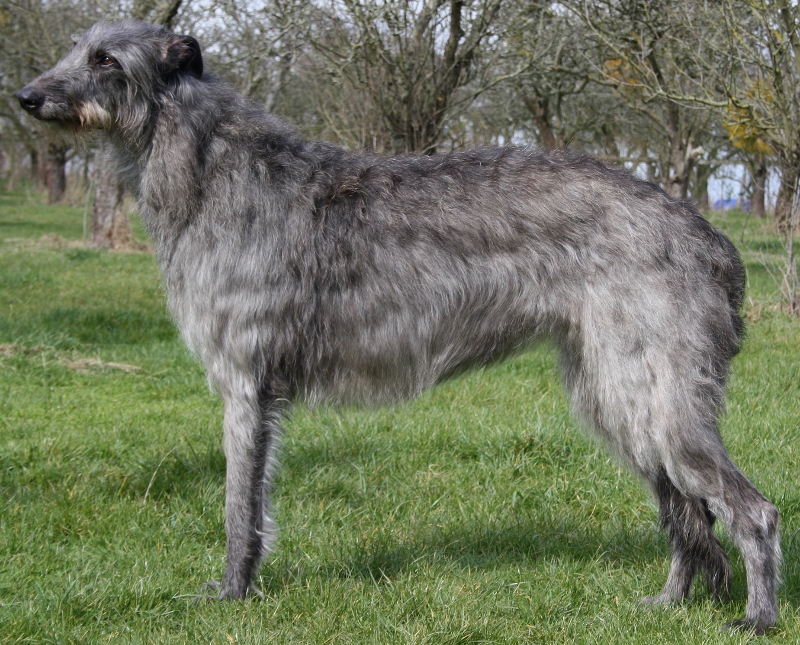 ody and general formation is that of a Greyhound of larger size and bone. Chest deep rather than broad, but not too narrow and flat-sided. The loin well arched and drooping to the tail. A straight back is not desirable, this formation being unsuitable for going uphill and very unsightly.
ody and general formation is that of a Greyhound of larger size and bone. Chest deep rather than broad, but not too narrow and flat-sided. The loin well arched and drooping to the tail. A straight back is not desirable, this formation being unsuitable for going uphill and very unsightly.
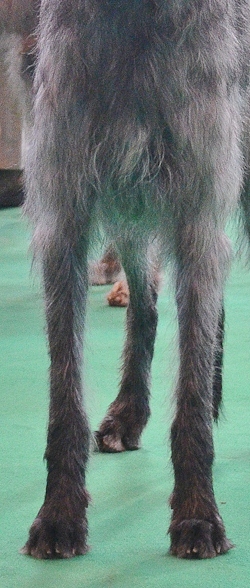 A D
A D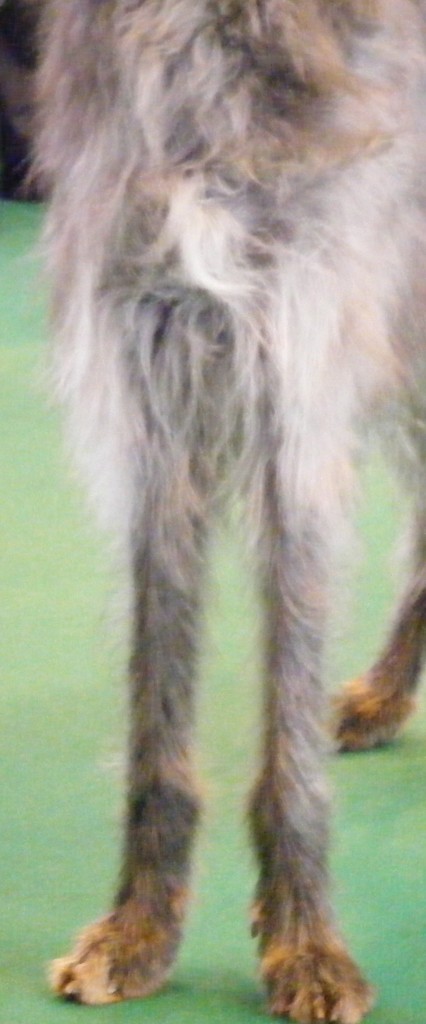 eerhound, just like a Greyhound, should be a little longer than high. You should always feel the body because a rich coat often makes it look shorter than it is, both in body length and in leg length. A Deerhound must have a clearly visible arch over the loin. The highest point of the lumbar curve is most beautiful at the fourth vertebra after the last thoracic vertebra.The slope of the pelvis is about 45 degrees, because of this you get a beautiful croup which must be long and strongly widened to the ischium with at least 8 cm between the hip bones. The hind legs are slightly wider than the front legs.
eerhound, just like a Greyhound, should be a little longer than high. You should always feel the body because a rich coat often makes it look shorter than it is, both in body length and in leg length. A Deerhound must have a clearly visible arch over the loin. The highest point of the lumbar curve is most beautiful at the fourth vertebra after the last thoracic vertebra.The slope of the pelvis is about 45 degrees, because of this you get a beautiful croup which must be long and strongly widened to the ischium with at least 8 cm between the hip bones. The hind legs are slightly wider than the front legs.
With an athlete like the Deerhound it is most beautiful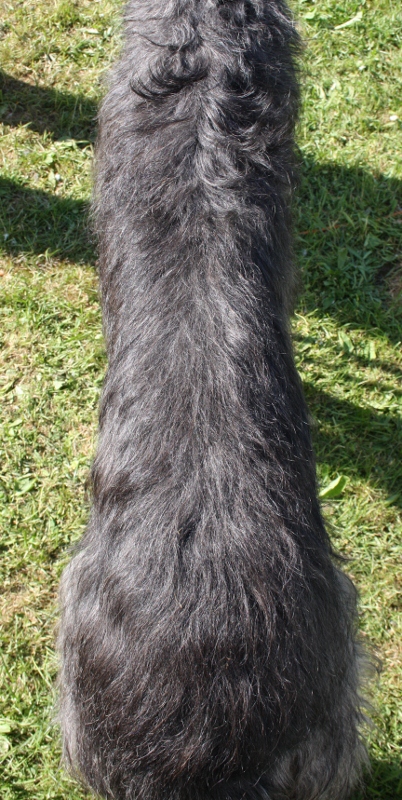 when the chest reaches just above the elbows. This makes the hound more agile. He must also have enough space between the front legs so that the front is not too narrow. This is only possible if the forchest is prominent. The sternum should not be too short and can reach up to 20 centimetres behind the elbows. Good spring of rib is also very important, this gives
when the chest reaches just above the elbows. This makes the hound more agile. He must also have enough space between the front legs so that the front is not too narrow. This is only possible if the forchest is prominent. The sternum should not be too short and can reach up to 20 centimetres behind the elbows. Good spring of rib is also very important, this gives 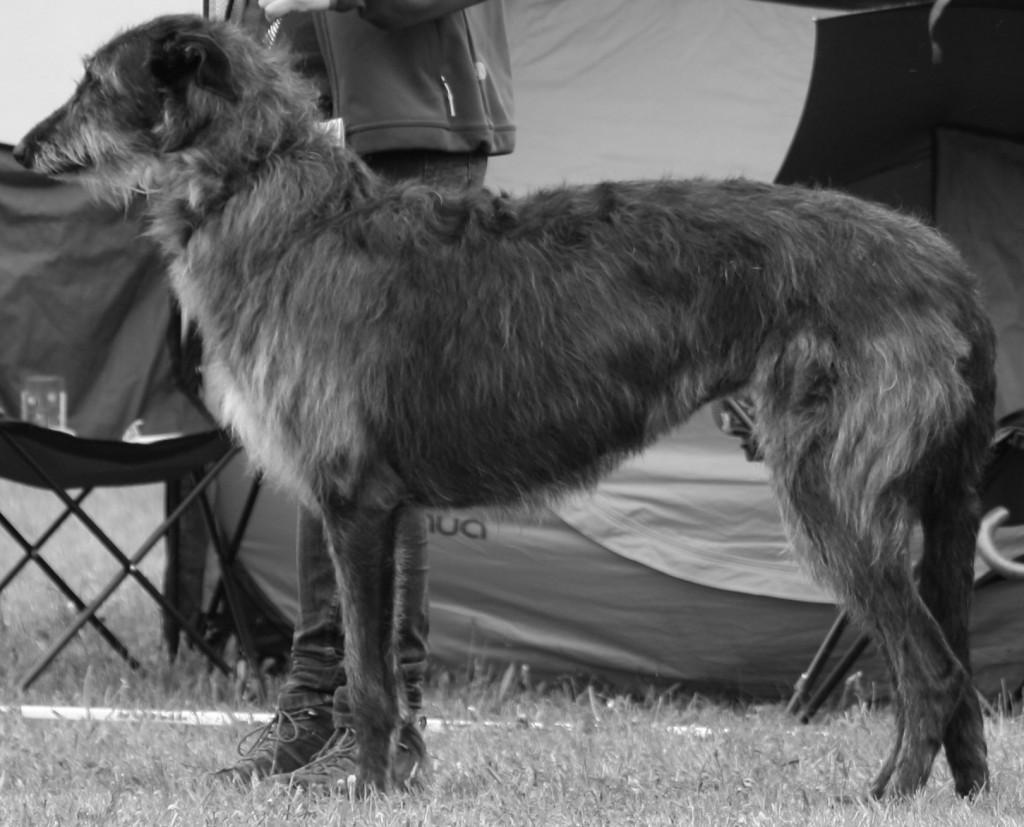 room to heart and lungs. Today we see a lot of hounds with really little spring of rib. The first ribs after the shoulders are still somewhat flat, but after this they should be more curved so that they are at least as wide as the shoulders when viewed from above. They should not be as curvaceous as the Irish Wolfhound but a little more like the Greyhound. Also further down they should not be too flat. A good Deerhound has a larger chest size than height at the withers!
room to heart and lungs. Today we see a lot of hounds with really little spring of rib. The first ribs after the shoulders are still somewhat flat, but after this they should be more curved so that they are at least as wide as the shoulders when viewed from above. They should not be as curvaceous as the Irish Wolfhound but a little more like the Greyhound. Also further down they should not be too flat. A good Deerhound has a larger chest size than height at the withers!

TAIL: Long, thick at root, tape ring and reaching almost to ground. When standing dropped perfectly straight down or curved. Curved when moving, never hitchhiked above line of back. Well covered with hair; On upper side thick and wiry, on  under side longer and towards end a slight fringe is not objectionable. A curl or ring tail undesirable.
under side longer and towards end a slight fringe is not objectionable. A curl or ring tail undesirable.
TAIL: Should be long, thick at the root, tape ring and reaching to within about 1.5 inches of the ground. When the dog is still, dropped perfectly straight down or curved. When in motion it should be curved when excited, in no case to be lifted out of the line of the back. It should be well-covered with hair; On the inside, thick and wiry; On the underside longer, and towards the end a slight fringe is not objectionable. A curl or ring tail is very undesirable.
A beautiful Deerhound tail is long, well hairy, thick at the root, without nodding or bobblesing and descending into a point. With long we mean about 2 to 5 cm above the ground, which is the most beautiful. A tail to the hock, a ring or curling tail and a badly hairy tail are really ugly. What absolutely damages the beautiful, flowing lines of a Deerhound is a tail that is carried too high, which we unfortunately often see.
A beautiful tail, like a beautiful mane, is an ornament for the Deerhound.

LIMBS:
FOREQUARTERS
FORLEGS: straight, broad and flat. SHOULDER: Well laid, not too far apart. Loaded and straight shoulders undesirable. ELBOW: Good breadth desirable. FOREARM: Good breadth desirable. FOREFEET: Compact and well knuckled. Nails Strong.
HINDQUARTERS: With great length from hip to hock. Bone broad and flat. STIFLE (Knee): Well Bent. HINDFEET: Compact and well knuckled. Nails Strong.
FOREQUARTERS: The shoulders should be well sloped, the blades well back and not too much width between them. Loaded and straight shoulders are very bad faults. The fore-legs should be straight, broad and flat, a good broad forearm and elbow being desirable.
HINDQUARTERS: Drooping, and as broad and powerful as possible, the hips being set wide apart. The hind legs should be well bent at the stifle, with great length from hip to the hock, which should be broad and flat.
FEET: Should be close and compact, with well-arranged toes. Nails Strong.
If yo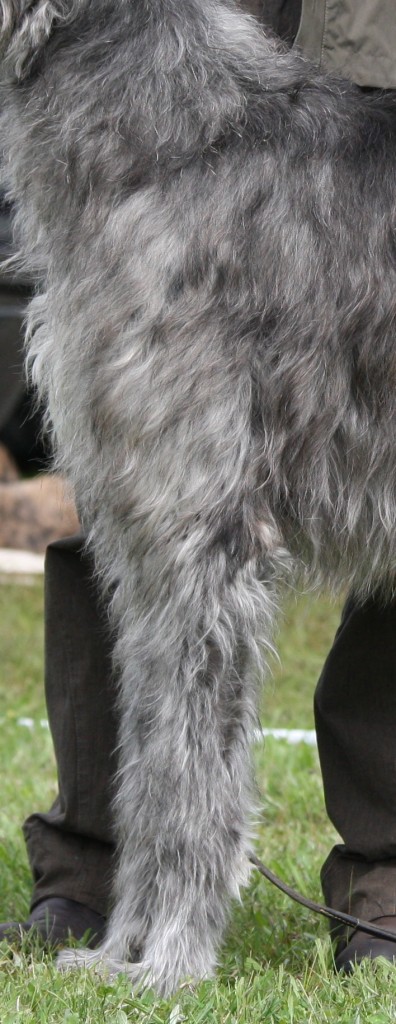 u look at the back of a Deerhound, the first thing that comes into your mind must be “strength”. Both from the side and from behind, it has to look stable and very powerful. This must also be expressed in the movement. Over the leg length is not spoken anywhere but in the book of Curtis M. Brown but it is mentioned that a good Deerhound must have a leg length-height ratio of 1.27-1. And when I look at the good working hounds this is right. In any case, the leg length is always clearly more than half the height of the withers, but remember that a lot of hair makes the hound appear shorter on the leg. So always feel good! Nothing is said about the number of degrees of
u look at the back of a Deerhound, the first thing that comes into your mind must be “strength”. Both from the side and from behind, it has to look stable and very powerful. This must also be expressed in the movement. Over the leg length is not spoken anywhere but in the book of Curtis M. Brown but it is mentioned that a good Deerhound must have a leg length-height ratio of 1.27-1. And when I look at the good working hounds this is right. In any case, the leg length is always clearly more than half the height of the withers, but remember that a lot of hair makes the hound appear shorter on the leg. So always feel good! Nothing is said about the number of degrees of 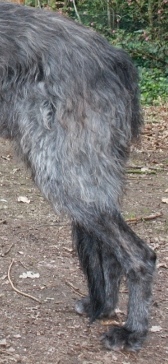 the angles but the most beautiful is if the angle shoulder blade-humerus is about 115 to 120 degrees and the tip of the shoulder blade is perpendicularly above the elbow. However, the humerus must be clearly longer (about 2 cm) than the shoulder blade, so the humerus is slightly steeper than the shoulder blade. In the backhand, there must be a lot of length from hip to hock. Regularly we see that the first thigh (femur) is too short, it looks very unbalanced.
the angles but the most beautiful is if the angle shoulder blade-humerus is about 115 to 120 degrees and the tip of the shoulder blade is perpendicularly above the elbow. However, the humerus must be clearly longer (about 2 cm) than the shoulder blade, so the humerus is slightly steeper than the shoulder blade. In the backhand, there must be a lot of length from hip to hock. Regularly we see that the first thigh (femur) is too short, it looks very unbalanced.
Also, the Deerhound should have a flat ‘ bone ‘. This means that from the side seen the front leg 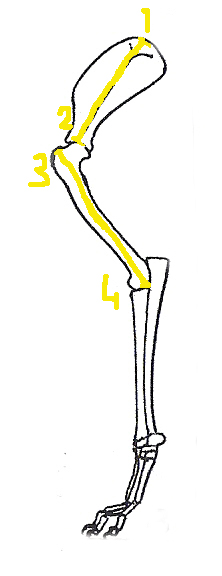 is wide but narrowly seen from the front; In other words, the cross-section of the forearm is oval. The other parts must also show flat. It is very important that the Deerhound as an athlete has some flexibility in the wrists, about 15 degrees is the most beautiful. Many judgers claim that in the greyhounds the length of the shoulder blade and the humerus is equally long, but this stems from the fact that it is measured incorrectly. It is then measured from 1 to 3 and from 3 to 4. Then the distances are indeed right but this is not the length of the bones! The length of
is wide but narrowly seen from the front; In other words, the cross-section of the forearm is oval. The other parts must also show flat. It is very important that the Deerhound as an athlete has some flexibility in the wrists, about 15 degrees is the most beautiful. Many judgers claim that in the greyhounds the length of the shoulder blade and the humerus is equally long, but this stems from the fact that it is measured incorrectly. It is then measured from 1 to 3 and from 3 to 4. Then the distances are indeed right but this is not the length of the bones! The length of 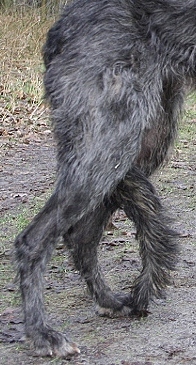 the shoulder blade runs from 1 to 2 and the length of the humerus runs from 3 to 4. As measured, it will be shown that in almost all sighthounds the humerus is longer than the shoulder blade.
the shoulder blade runs from 1 to 2 and the length of the humerus runs from 3 to 4. As measured, it will be shown that in almost all sighthounds the humerus is longer than the shoulder blade.
GAIT/MOVEMENT: Easy, Active and true, with a long stride.
Act ually, this should say enough, but it turns out that many people have a lot of trouble recognizing a good gait. The “Easy” is recognized by the fact that it takes the hound totally no effort to move forward, it goes as saying, the hound almost floats. “Active” is that the hound does not shuffle, moving with an active posture at a good pace and “true” is that the legs move without swinging, in a straight line, from front to back and from top to bottom (i.e. not cowhocked, narrow, French or with twisted elbows/knees). However, the hound must converge, that is, the feet, at a higher pace than step, come to each other.
ually, this should say enough, but it turns out that many people have a lot of trouble recognizing a good gait. The “Easy” is recognized by the fact that it takes the hound totally no effort to move forward, it goes as saying, the hound almost floats. “Active” is that the hound does not shuffle, moving with an active posture at a good pace and “true” is that the legs move without swinging, in a straight line, from front to back and from top to bottom (i.e. not cowhocked, narrow, French or with twisted elbows/knees). However, the hound must converge, that is, the feet, at a higher pace than step, come to each other. 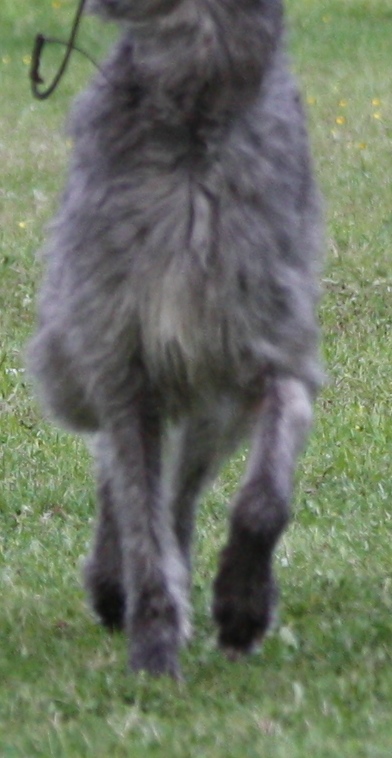 If the hound trots very quickly, the pawprints will almost be in a straight line. If the hound does not do this, then the centre of gravity will swing back and forth during walking, thereby hindering the locomotion. The walking looks laborious. The “long stride” arises when the hound is well-angled and the front and rear angles are in balance. During the trot the foot must come from behind, low over the ground (not as low as the German Shepherd), put forward and approximately, in the case of a correct head position, come down under the eye to the ground. The head should not be worn high.
If the hound trots very quickly, the pawprints will almost be in a straight line. If the hound does not do this, then the centre of gravity will swing back and forth during walking, thereby hindering the locomotion. The walking looks laborious. The “long stride” arises when the hound is well-angled and the front and rear angles are in balance. During the trot the foot must come from behind, low over the ground (not as low as the German Shepherd), put forward and approximately, in the case of a correct head position, come down under the eye to the ground. The head should not be worn high.
The Deerhound has a slightly upward movement due to the well-angulated hindquarters and the arched loin. This means that when you look at the topline while trotting, it does not move in a straight line, but in a wavy line.
A Deerhound must dance!
Also during the trot a Deerhound must retain the arch over the loin.
Because the hound shown above has more angle in the backhand than in the front, it lifts his front leg too high and has more range than behind. It looks “beautiful” in the ring but it’s not the “easy going” movement we like to see from the Deerhound.
Very correct body postures and balanced movement. Note: The arch over the loin of the rear hound makes it appear that the front hound has a wrong topline.
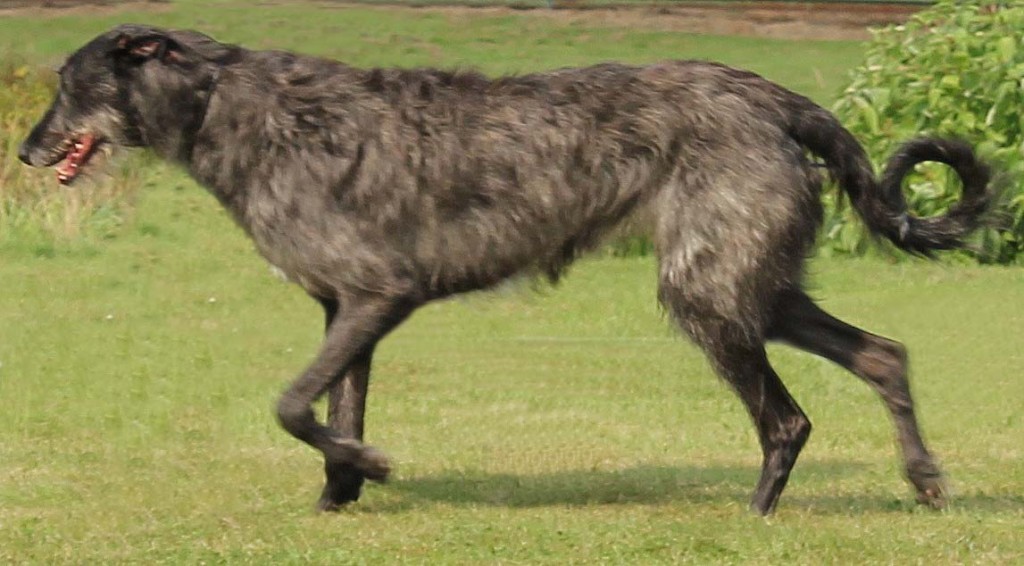
COAT: 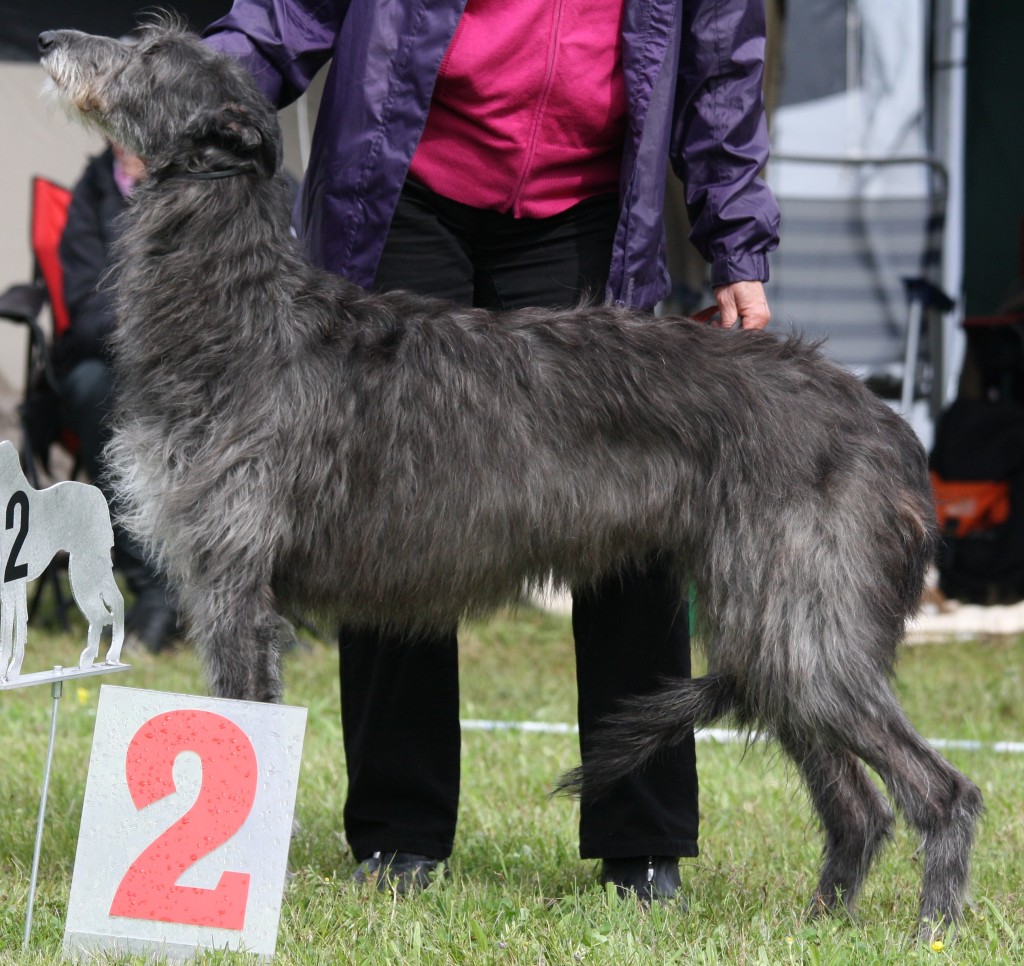
HAIR: Shaggy, but not overcoated. Woolly coat is unacceptable. The correct coat is thick, close-lying, ragged; Harsh or crisp to the touch. Hair on body, neck and quarters harsh and wiry about 8 cm to 10 cm long; That on head, breast and belly much softer. A slight hairy fringe on inside of fore-and hindlegs.
COLOUR: Dark blue-grey, darker and lighter greys or brindles and yellows, sandy-red or red fawns with black points. A white chest, white toes and a slight white tip to stern are permissible but the less white the better, since it is a self-coloured dog. A White blaze on head or white collar is unacceptable.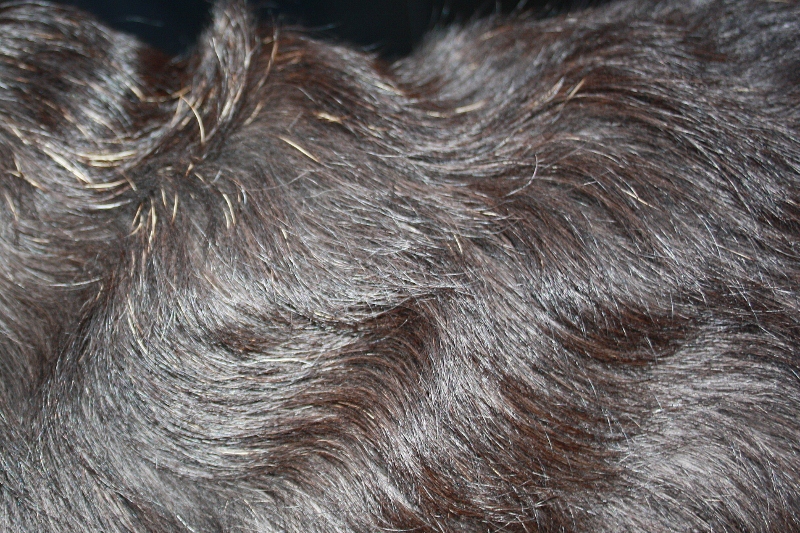
COAT:
Hair: The hair on the body, neck and quarters should be harsh and wiry, and about three or four inches long; That on the head, breast and belly is much softer. The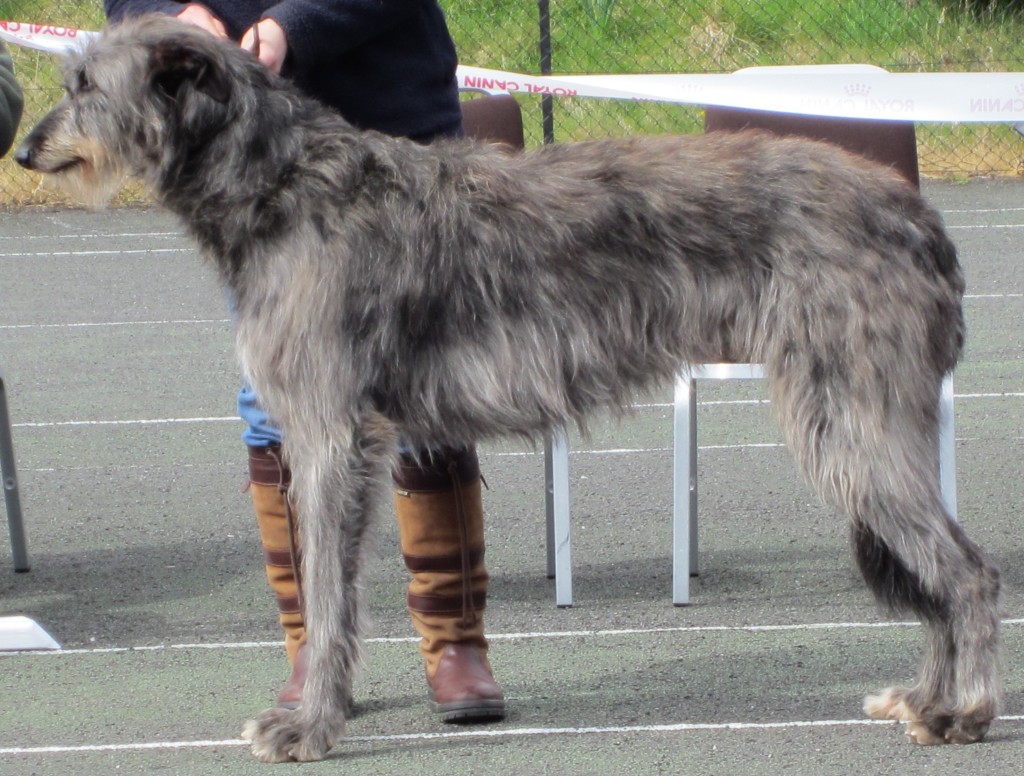 re should be a slight hairy fringe on the inside of the fore and hind legs, but nothing approaching the “feather” of a Collie. The Deerhound should be a shaggy dog, but not over-coated. A woolly coat is bath. Some good strains have a mixture of silky coat with the hard, which is preferable to a woolly coat; But the clean coat is a thick, close-lying, ragged coat, harsh or crisp to the touch.
re should be a slight hairy fringe on the inside of the fore and hind legs, but nothing approaching the “feather” of a Collie. The Deerhound should be a shaggy dog, but not over-coated. A woolly coat is bath. Some good strains have a mixture of silky coat with the hard, which is preferable to a woolly coat; But the clean coat is a thick, close-lying, ragged coat, harsh or crisp to the touch.
Colour: Colour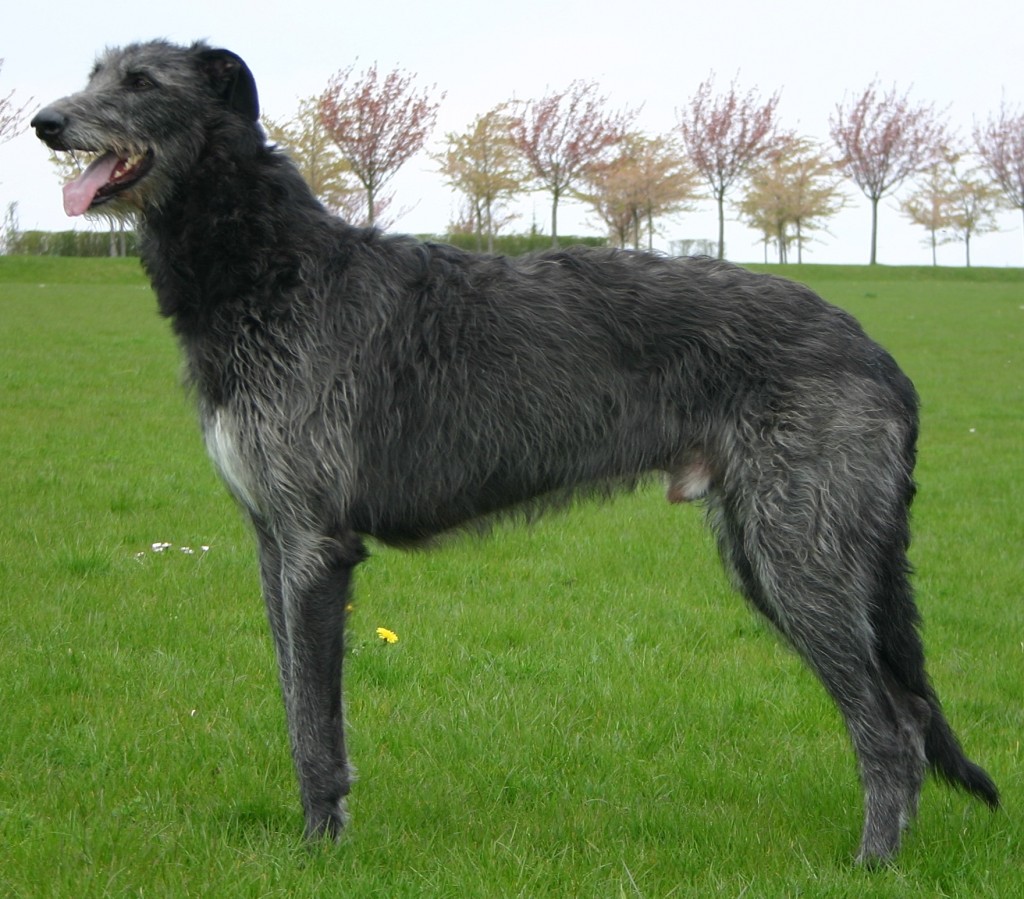 is much a matter of fancy. But there is no manner of doubt that the dark blue-grey is the most preferred because quality tends to follow this colour. Next comes the darker and lighter greys or brindles, the darkest being generally preferred. Yellow and sandy-red or red-fawn, especially with black points, i.e. ears and muzzles, are also in equal estimation, this being the colour of the oldest known strains, the McNeil and Chesthill Menzies. White is condemned by all the old authorities, but a white chest and white toes, occurring as they do in a great many of the darkests-coloured dogs, are not so great objectsed to, but the less the better, as
is much a matter of fancy. But there is no manner of doubt that the dark blue-grey is the most preferred because quality tends to follow this colour. Next comes the darker and lighter greys or brindles, the darkest being generally preferred. Yellow and sandy-red or red-fawn, especially with black points, i.e. ears and muzzles, are also in equal estimation, this being the colour of the oldest known strains, the McNeil and Chesthill Menzies. White is condemned by all the old authorities, but a white chest and white toes, occurring as they do in a great many of the darkests-coloured dogs, are not so great objectsed to, but the less the better, as 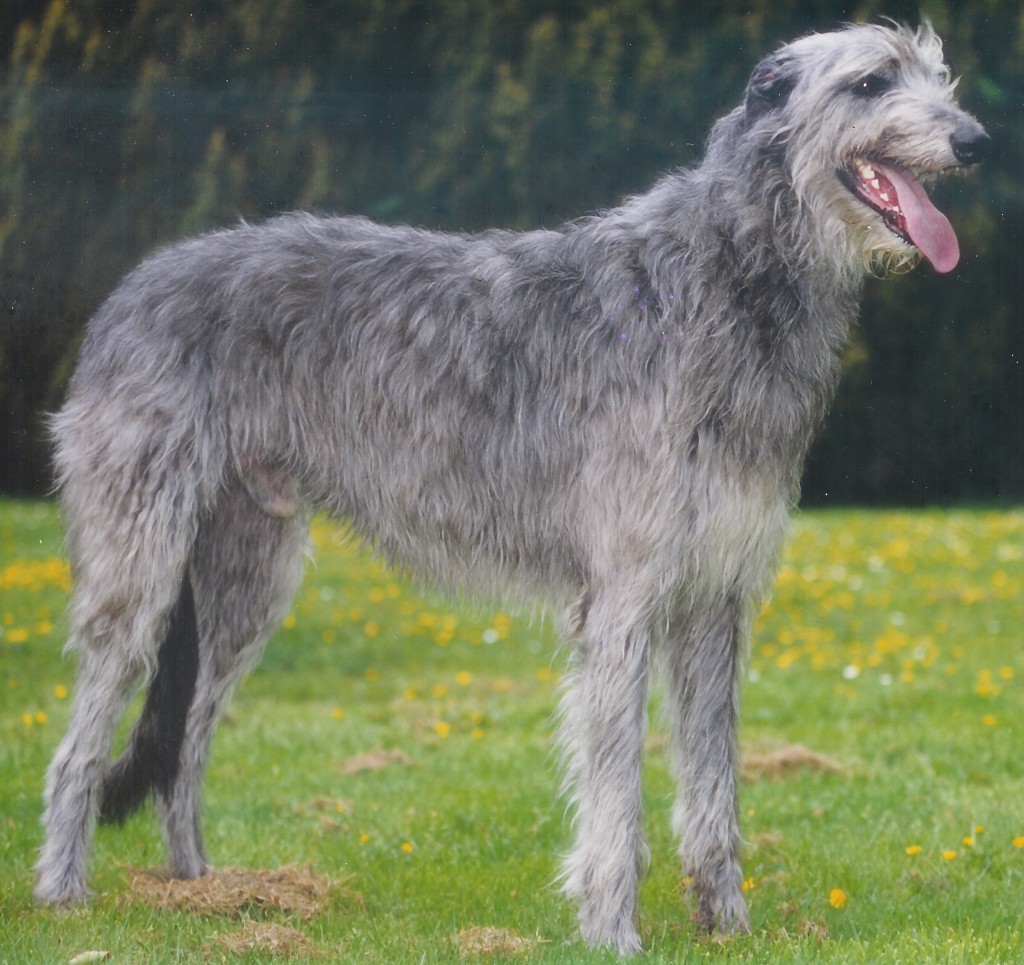 the Deerhound is a self-coloured dog. A white blaze on the head, or a white collar should be heavily penalised. In other cases, though passable, yet an attempt should be made to get rid of white marks. The less white the better but a slight white tip to the stern occurs in the best strains.
the Deerhound is a self-coloured dog. A white blaze on the head, or a white collar should be heavily penalised. In other cases, though passable, yet an attempt should be made to get rid of white marks. The less white the better but a slight white tip to the stern occurs in the best strains.
You hardly come across the real right harsh coat anymore. Also, in certain bloodlines, many coats are much too short and in other lines, the hounds are over-haired, with an exaggerated amount of furnishings and undercoat. The older Deerhound usually gets a fuller and longer coat, and the furnishings also increases. 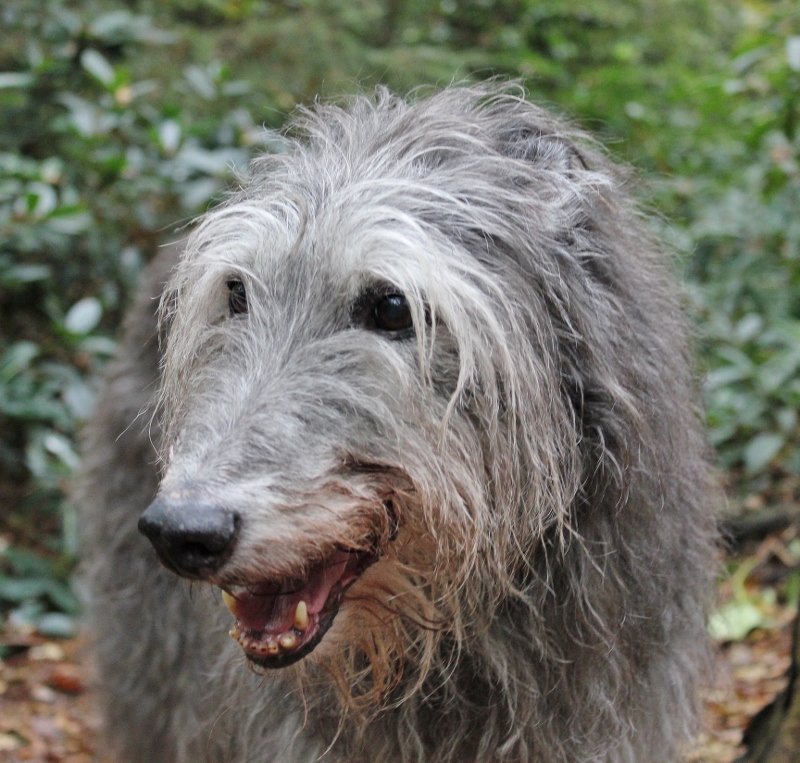 In the last century a woolly was regularly bred to improve the build. The woolly usually has stronger angulations and more powerful bone, they are usually almost perfect in construction. Even a well-trimmed woolly can be recognized by too much and too soft hair, especially on the legs and ears. The color can change regularly over the course of the Deerhound’s life. They are born very dark and can then light up to silver-grey. After five or six years they can suddenly be very dark again, but this is not necessary, they can also remain silver-grey. Diet can have a major influence on this.
In the last century a woolly was regularly bred to improve the build. The woolly usually has stronger angulations and more powerful bone, they are usually almost perfect in construction. Even a well-trimmed woolly can be recognized by too much and too soft hair, especially on the legs and ears. The color can change regularly over the course of the Deerhound’s life. They are born very dark and can then light up to silver-grey. After five or six years they can suddenly be very dark again, but this is not necessary, they can also remain silver-grey. Diet can have a major influence on this.
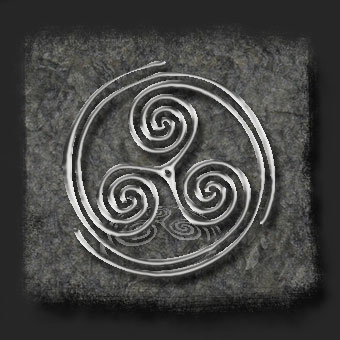
SIZE AND WEIGHT: males: Minimum desirable height at withers 76 cm. Weight about 45.5 kgs. Females: Minimum desirable height at Withers 71 cm. Weight about 36.5 kgs.
WEIGHT AND SIZE: Should be from 85 to 105 lbs. In dogs and from 65 to 80 lbs. In bitches. Height of dogs should not be less than 30 inches and bitches 28 inches at the shoulder, respectively.
We often see that excellent “small” breedrepresentatives finish in a lower place in the show ring than (very) good larger ones. This is of course a bad thing. Of course the Deerhound should not be too small and fine, but the minimum size has already been increased once and we must ensure that it is not a refined Irish Wolfhound. And frankly, in all these 37 years, I have seen only one Deerhound too small.
Faults: Any departure from the foregoing points should be considered a fault and the seriousness with which the fault should be regarded should be in exact proportation to its degree and its effect upon the health and welfare of the dog and on its ability to perform its traditional work.
DISQUALIFYING faults: Aggressive or overly shy dogs. Any dog clearly showing physical or behavioural abnormalitiess shall be disqualified.
N.B.: Male Animals should have two apparently normal testicles fully descended into the scrotum.
Faults: Thick ear hanging flat to the head, or heavily coated with long hair. Curl or ring tail. Light Eye. Straight back. Cow Hall, weak pasterns, straight stifles, splay feet, woolly coat, loaded and straight shoulders, white marks.
Common mistakes at the moment are: atypical head, too light eyes, too large ears, no strong nape, too steep in front, too flat topline, too little spring of rib and too weak feet. These are therefore points of attention for the judges and breeders. The old standard also mentions ‘ white markings ‘. It does not actually occur, but lately you can see hounds with a breast stain that goes up to the chin. I would like to make this a mistake. It is of course very difficult to be able to judge in the show ring whether a Deerhound is suitable for his work. The “funny” thing is that there are (almost) no judges who have ever seen a Deerhound really does his work, so how should they know how a Deerhound brings down a deer? As a judge you can only observe that the hound is or is not properly assembled, can or may not run well, or is not well muscled. What I do find sensible is the addition of the character traits. It seems it is necessary to mention this extra and it is only to be hoped that my fellow judges will also judge this more, because it often happens that very anxious specimens are simply placed or even win!
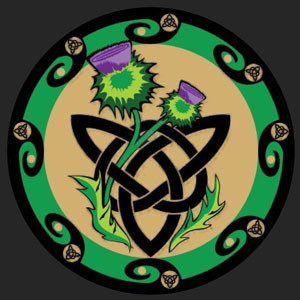
The English Deerhound Club has also compiled a list of points in order of importance at the same time as the first standard.
POINTS of THE DEERHOUND (in order of importance).
1. Typical. A Deerhound should resemble a rough coated greyhound of larger size and bone.
2. Movements easy, active and true.
3. As tall as possible consistent with quality.
4. Head – long, level, well balanced, carried high.
5. Body – long, very deep in brisket, well sprung ribs and great breadth across hips.
6. Forelegs – strong and quite straight, with elbows neither in nor out.
7. Thighs – long and muscular, second thighs well muscled, stifles are nicely bent.
8. Loins – well arched and belly well drawn up.
9. Coat – rough and hard, longer and softer beard and browse.
10. Feet – close and compact with well knuckled toes.
11. Ears – small with greyhound-like carriage.
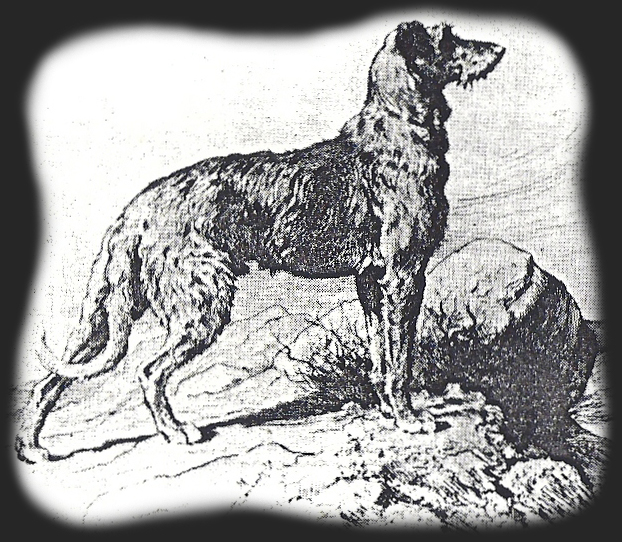
12. Eyes – dark, moderately full.
13. Neck – long, well arched and very strong with prominent nape.
14. Shoulders – clean, set slooping.
15. Chest – very deep but not too
narrow.
16. Tail – long and slightly curved, carried low.
17. Teeth – strong and level.
18. Nails – strong and curved.
Point 1. Type is of course most important and I would like to point out that there are currently types that do not meet the standard. That is why it is very important to keep an eye on the image of the right type. The correct type always consists of curved lines and the size of the breast is greater than the height of the withers. Keywords: rugged, powerful and elegant.
Point 2. Movement, in this list of points, in contrary to the very first standard, something is mentioned about the movement; Namely, EASY, ACTIVE and TRUE. Norah Hartley describes the movement as follows; “From the side, th
e hound should have a good stride length with both the front legs and the hind legs, a lot of ground with each step. The feet come well from the ground-‘ daisy clipping ‘ is not desired but of course no ‘ Hackney ‘ movement. From the front and from the back, the legs must be quite parallel to each other and in a right angle with the ground, not to swing inwards or outward, moving: come in and go it should look as if the hound has only two legs “. The latter is of course biodynamic not justified. If the hound would trot in this way, his entire body would swing back and forth, the center of gravity constantly moves from left to right. Especially with our hounds we soon see that they go “single track” in a higher speed.
Point 3. Size comes naturally from the early period. Then most Deerhounds were much smaller anyway than now. Now the smallest Deerhound is as big as when the normal size was. Size is not a problem in our breed.
Point 4. It says carried high, Deerhounds do that when expecting game, when they are walking in an area that is of interest to them. But if you want to see a balanced gait they should not carry the head high, this cannot go together anatomically.
Point 13. A strong nape is required to take down a deer. Unfortunately, we rarely see “the prominent nape”.
Point 17. Fort
unately, we have no real dental problems with the Deerhound. Very occasionally you see a pincer bite, or overbite but missing elements is rare.
I would like to reiterate a few very important points, which are so characteristic of the Deerhound.
As;
![]() The Deerhound is made up of curved lines, there should be nothing angular to a Deerhound.
The Deerhound is made up of curved lines, there should be nothing angular to a Deerhound. 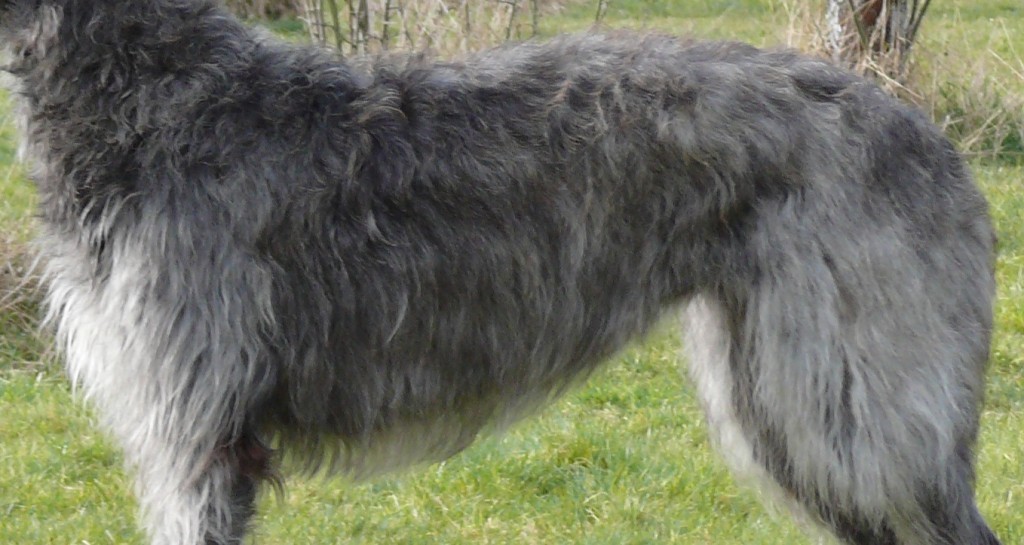 From the tip of the nose to the tip of the tail should be one smooth curvy line. The underline is S-shaped. From the clearly tactile front chest, through the sternum that almost richly extends to the elbows and passes quite long, the line goes quite strongly up into the raised loins. But it should not appear on a wasp waist. Robust elegance, are the words that apply.
From the tip of the nose to the tip of the tail should be one smooth curvy line. The underline is S-shaped. From the clearly tactile front chest, through the sternum that almost richly extends to the elbows and passes quite long, the line goes quite strongly up into the raised loins. But it should not appear on a wasp waist. Robust elegance, are the words that apply.
A quote from Captain Graham: “The general appearance should be striking, elegant and aristocratic to a marked degree, and nobility of carriage is a very strong feature in the breed”
![]() The head consists of parallel lines, or the nose and skull line are almost parallel. When the front is pointing do
The head consists of parallel lines, or the nose and skull line are almost parallel. When the front is pointing do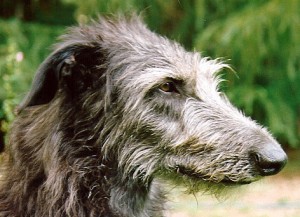 wnwards, the Hound is “downfaced”, which is good for a bull terrier but not for a Deerhound.
wnwards, the Hound is “downfaced”, which is good for a bull terrier but not for a Deerhound. 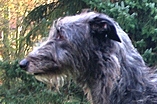 The head also loses nobility.
The head also loses nobility.
![]() The feet are very important! The foot pads must be large and thick. It should appear that the Deerhound got rubber balls are under his feet. As with any sighthound, the feet of the Deerhound must also be able to absorb huge blows. You should not forget that they will land on one foot each time when they are running with about 50 kilometers per hour (and a good male can weight 45 to 50 kilos). Then the feet must be strong and powerful!
The feet are very important! The foot pads must be large and thick. It should appear that the Deerhound got rubber balls are under his feet. As with any sighthound, the feet of the Deerhound must also be able to absorb huge blows. You should not forget that they will land on one foot each time when they are running with about 50 kilometers per hour (and a good male can weight 45 to 50 kilos). Then the feet must be strong and powerful!
![]() In the standard state pretty much written about the ears but did you know that the crazier a Deerhound can do with his ears, the better the ears are? And the smaller the better… But what is small? If you pull the ear forward and it comes to the outer corner or just on the eye, then you have a small ear. Also the ears do not have to feel fleshy.
In the standard state pretty much written about the ears but did you know that the crazier a Deerhound can do with his ears, the better the ears are? And the smaller the better… But what is small? If you pull the ear forward and it comes to the outer corner or just on the eye, then you have a small ear. Also the ears do not have to feel fleshy.
The standard of course describes an adult Deerhound. As most Deerhounds are shown fairly young and soon gleaned their championships together, we see relatively little grown Deerhounds in the ring. A Deerhound bitch is usually only “finished” at an age of about 3 to 4 years and the male will quickly be 5 years old before he really has grown out. Also the furnishings can come through well at much later age, this is quite different per bloodline. As a judge, it is therefore very important to delve deeper into the breed and to know how a Deerhound changes over the years.
I hope that with this “standard in Word and image” I have been able to make things clearer for those who are interested in this and have been able to contribute to the better understanding, seeing, feeling and judging of “the Most Perfect Creature of Heaven “.
